ICISite Interface
The ICISite interface represents an individual Site. (Refer to ICISites - Multi-Site Management to view/make changes to all of the Sites at once or to create a new Site.)
For example: Set Site = Sites.Item(0)
interface ICISite : IDispatch
Jump to: B C D E F G H I K L M N O P R S T U V W
Scroll down for dialog box equivalents.
For SFTPAdvBool, used below:
For PwdType, used below:
- 0 = Regular (hashed)
- 1 = Anonymous (regular with empty password)(removed in v7.3.3.21 and later)
- 2 = Anonymous (require email as password) (removed in v7.3.3.21 and later)
- 3 = OTP-MD4 (removed in v7.3.3.21 and later)
- 4 = OTP-MD5
- 5 = Literal (no hash) - For use when importing shadow passwords from a *nix password file. The format must follow: $1$*$* For example, user: test, password: test would be: site.ChangeUserPassword "test", "$1$Bn3YdWKv$.BS3Qb2UQTV4SmV1JNN.w/", 5
- 6 = nPwdType - For importing hashes of unknown type from another source.
(When the user logs into EFT, EFT would cycle
through possible hashes for the plaintext password to see which one
matches the supplied hash. When a match is found, the user is able
to log in. As well, EFT will rehash the password with its current
default hashing algorithm and store that as the user's hashed password.)
Members (Listed alphabetically)
In the EFT administration interface, this property is enabled on the Site's Connection tab.
Retrieves the account management URL at which users can reset their passwords via HTTPS. You must restart the Site for the change to take effect. (Refer to Stop and Start below.)
HRESULT AccountManagementPath([out, retval] BSTR* pVal);
Example (VBScript):
MsgBox "Account management over https path is: " & CStr(oSite.AccountManagementPath)
EFT v6.3 and later
Function AddAdvancedWorkflow(pdisplParams As Object) As Long
Adds new Advanced Workflow to this Site.
HRESULT AddAdvancedWorkflow([in] IDispatch* pdisplParams, // AW params // as ICIAdvancedWorkflowParams *l[out, retval] long* plIndex);// zero-based index of created AW
Example (VBScript):
set AWParams = CreateObject("SFTPCOMInterface.CIAdvancedWorkflowParams") ‘...setup workflow site.AddAdvancedWorkflow(AWParams)
EFT v6.5 and later
Moves a pending certificate to trusted.
HRESULT AddCertificateToTrusted([in] long lID, [out, retval] long *lNewID);
Example (VBScript):
'Loop through pending certificates 'and assign certificate to a client 'if the certificate common name 'coincides with client's full name For Each pID in Site.GetPendingCertificates If Site.GetPendingCertificateInfo(pID).SubjectCName = C.FullName Then tID = Site.AddCertificateToTrusted(pID) C.SetSSLAuthenticationType "key" C.SetSSLKeyID tID End If Next
All versions
Function AddConnectionProfile(pdispParams As Object) As Long
See also RemoveConnectionProfile.
HRESULT AddConnectionProfile( [in] IDispatch* pdispParams, [out, retval] LONG* plIndex);
EFT v7.2 and later
Method AddContentIntegrityControlProfile
Add CIC profile:
HRESULT AddContentIntegrityControlProfile([in] IDispatch* pProfile);
EFT v8
Sub AddEncryptedFolder(pIEncryptedFolder As Object)
HRESULT AddEncryptedFolder([in]IDispatch* pIEncryptedFolder);
EFT v7.4.13 and later
Sub AddIPAccessRule
Adds allowed or denied IP mask for the Site. (default value and Reason added in v8)
HRESULT AddIPAccessRule( [in] BSTR bstrMask, [in] VARIANT_BOOL bAllow, [in] long nRulePos, [in, defaultvalue("")] BSTR bstrReason);
Example (VBScript):
oSite.AddIPAccessRule("1.2.3.4", false, 2)
All versions
See also the following interfaces:
Used to add a new Upload Form to the Site.
HRESULT AddUploadForm([in] IDispatch* pUploadForm);
EFT v8.0.4 and later
Sub AddUserToPermissionGroup(bstrUser As String, bstrGroup As String)
Adds a user to a permission group.
HRESULT AddUserToPermissionGroup( [in] BSTR bstrUser, [in] BSTR bstrGroup);
All versions
Retrieves the total count of site's Advanced Workflows.
HRESULT AdvancedWorkflowsCount([out, retval] long* plValue);
Example (VBScript):
If Site.AdvancedWorkflowsCount = 0 Then ‘Site has no Advanced Workflows … End If
EFT v6.5 and later
Site's Advanced Workflow folders for organizing workflows.
HRESULT AdvancedWorkflowFolders([out, retval] IDispatch** ppdispAdvancedWorkflowFolders);
EFT v8.1 and later
Property AllowChangePassword As Boolean
Allows you to retrieve or specify whether Site users are allowed to change their passwords. The value can be overridden at the Settings Template or user account level.
HRESULT AllowChangePassword([out, retval] VARIANT_BOOL *pVal); HRESULT AllowChangePassword([in] VARIANT_BOOL val);
Examples (VBScript):
If Site.AllowChangePassword Then Site.ForcePasswordResetOnInitialLogin = True End If
Specifying:
If Site.AllowChangePassword = False
EFT v6.2 and later
Used to enable or disable clear command channel.
HRESULT AllowClearCommandChannel([in] VARIANT_BOOL newVal); HRESULT AllowClearCommandChannel([out, retval] VARIANT_BOOL *pVal);
EFT v8.0.5 and later
Property AllowEmailLoginCredentials As Boolean
Retrieves or specifies whether allow login credentials to be sent in emails. If AllowEmailLoginCredentials is enabled, EmailLoginCredentialsMode retrieves how they are sent (username and password in the same email, separate emails, or username only).
HRESULT AllowEmailLoginCredentials([out, retval] VARIANT_BOOL* pVal); HRESULT AllowEmailLoginCredentials([in] VARIANT_BOOL newVal);
TRUE=Email login credentials; FALSE=Do not email login credentials
Example (VBScript):
Retrieving:
if False = oSite.AllowEmailLoginCredentials then MsgBox "Disabled" End If
Specifying:
oSite.AllowEmailLoginCredentials = True
EFT v6.3 and later
Used to enable or disable unprotected data channel.
HRESULT AllowUnprotectedDataChannel([out, retval] VARIANT_BOOL *pVal); HRESULT AllowUnprotectedDataChannel([in] VARIANT_BOOL newVal);
EFT v8.0.5 and later
HRESULT AllowSuppressForgotPassword([out, retval] VARIANT_BOOL *pVal); HRESULT AllowSuppressForgotPassword([in] VARIANT_BOOL newVal);
EFT v7.4.11
Property AllowUPVariables As Boolean
Retrieves or specifies whether to allow username and passwords credentials as variables in Event Rules.
HRESULT AllowUPVariables([out, retval] VARIANT_BOOL* pVal); HRESULT AllowUPVariables([in] VARIANT_BOOL newVal);
Example (VBScript):
Retrieving:
if False = oSite.AllowUPVariables then MsgBox "Disabled" End If
Specifying:
oSite.AllowUPVariables = True
EFT v6.3 and later
HRESULT AllowWorkspacesOAIReply([out, retval] VARIANT_BOOL *pVal); HRESULT AllowWorkspacesOAIReply([in] VARIANT_BOOL newVal);
EFT v7.4.7 and later
Property AS2AccountManagementPath As String (read only)
Retrieves URL for AS2 account management.
HRESULT AS2AccountManagementPath([out, retval] BSTR* pVal);
Example (VBScript):
MsgBox "AS2 management path is: " & oSite.AS2AccountManagementPath
EFT v6.3 and later
Property AS2Certificate As String
Retrieves or specifies AS2 certificate path.
HRESULT AS2Certificate([out, retval] BSTR* pVal); HRESULT AS2Certificate([in] BSTR newVal);
Example (VBScript):
Retrieving:
MsgBox "AS2 certificate is: " & oSite.AS2Certificate
Specifying:
oSite.AS2Certificate = "C:\MyCerts\AS2Cert.crt"
EFT v6.3 and later
Property AS2Identifier As String
Retrieves or specifies the AS2 identifier.
HRESULT AS2Identifier([out, retval] BSTR* pVal); HRESULT AS2Identifier([in] BSTR newVal);
Example (VBScript):
Retrieving:
MsgBox "AS2 identifier is: " & oSite.AS2Identifier
Specifying:
oSite.AS2Identifier = "my_as2_id"
EFT v6.3 and later
Property AS2Passphrase As String
Retrieves or specifies the AS2 passphrase.
HRESULT AS2Passphrase([out, retval] BSTR* pVal); HRESULT AS2Passphrase([in] BSTR newVal);
Example (VBScript):
Retrieving:
MsgBox "AS2 passphrase is: " & oSite.AS2Passphrase
Specifying:
oSite.AS2Passphrase = "new_passphrase"
EFT v6.3 and later
Property AS2PrivateKey As String
Retrieves or specifies the AS2 private key.
HRESULT AS2PrivateKey([out, retval] BSTR* pVal); HRESULT AS2PrivateKey([in] BSTR newVal);
Example (VBScript):
Retrieving:
MsgBox "AS2 certificate is: " & oSite.AS2PrivateKey
Specifying:
oSite.AS2PrivateKey = "C:\MyCerts\AS2Cert.crt"
EFT v6.3 and later
Sub AssignEventRuleCustomCommandWorkingFolder(bstrCustomCommandName As String, bstrWorkingFolder As String)
Updates all instances of a given custom command in the event rule list to have a specified working folder.
HRESULT AssignEventRuleCustomCommandWorkingFolder( [in] BSTR bstrCustomCommandName, [in] BSTR bstrWorkingFolder);
Example (VBScript):
Dim strCommandName: strCommandName = "RunScript" Dim strNewWorkingFolder: strNewWorkingFolder = "C:\Script\folder" oSite.AssignEventRuleCustomCommandWorkingFolder(strCommandName, strNewWorkingFolder)
EFT v4.3.4 and later
Property AssignFullPermissionsForHomeFolder As Boolean
In the EFT administration interface, this property is enabled on the Site's Security tab, in the Account Security area.
Retrieves whether new users have full permissions in their home folders, and to either grant or deny users full permissions to their home folders. True = Granted (check box selected); False = Denied (check box cleared).
The AutoCreateHomeFolder property must be set to TRUE before you can use this property. If you do not grant users full permissions to their home folders, they will inherit permissions from their groups.
HRESULT AssignFullPermissionsForHomeFolder( [out, retval] VARIANT_BOOL *pVal); [in] VARIANT_BOOL newVal);
All versions
Property AutoBanIPsPermanently As Boolean
Retrieves or specifies whether to automatically ban IP addresses permanently.
HRESULT AutoBanIPsPermanently([out, retval] VARIANT_BOOL *pVal); HRESULT AutoBanIPsPermanently([in] VARIANT_BOOL newVal);
True=Permanently; False=Temporarily
All versions
Property AutobanSensitivity As AutobanSensitivity
Retrieves or specifies autoban sensitivity.
HRESULT AutobanSensitivity([out, retval] AutobanSensitivity *pVal); HRESULT AutobanSensitivity([in] AutobanSensitivity newVal);
Example (VBScript)::
Retrieving:
If Site.AutobanSensitivity <> SensitivityOff Then MsgBox "Flood/Hammer Autoban is on for the site" End If
Specifying:
Site.AutobanSensitivity = SensitivityVeryHigh
EFT v6.1 and later
Property AutoCreateHomeFolder As Boolean
In the EFT administration interface, this property is enabled on the Site's Security tab, in the Account Security area.
Retrieves whether the Site will automatically create a home folder for users, and to either enable or disable the automatic folder creation.
HRESULT AutoCreateHomeFolder([out, retval] VARIANT_BOOL *pVal); [in] VARIANT_BOOL newVal);
True = Enabled; False = Disabled
All versions
Property AverageSpeed As Long (read only)
Retrieves the average upload/download speed on the Site.
HRESULT AverageSpeed([out, retval] LONG* pVal);
Example (VBScript):
MsgBox "Average speed: " & CStr(oSite.AverageSpeed)
EFT v6.3 and later
When banning an IP address for invalid login attempts, specify whether to count incorrect username and correct username + incorrect password or only incorrect username attempts.
HRESULT BanIPForInvalidLoginAttempts([out, retval] VARIANT_BOOL* pVal); HRESULT BanIPForInvalidLoginAttempts([in] VARIANT_BOOL newVal);
TRUE = Count both 'incorrect username' and 'correct username + incorrect password'
FALSE = Count only incorrect username attempts
EFT v6.4 and later
Property BanIPForInvalidLoginAttemptsWithExistingUsername As Boolean
Retrieves or specifies whether to ban an IP address after excessive invalid login attempts with existing username and wrong password.
HRESULT BanIPForInvalidLoginAttemptsWithExistingUsername( [out, retval] VARIANT_BOOL* pVal); HRESULT BanIPForInvalidLoginAttemptsWithExistingUsername( [in] VARIANT_BOOL newVal);
EFT v6.4 and later
Property BanIPOnDOS As Boolean
Retrieves or specifies whether to ban an IP address after excessive invalid commands.
HRESULT BanIPOnDOS([out, retval] VARIANT_BOOL *pVal); HRESULT BanIPOnDOS([in] VARIANT_BOOL newVal);
True=Enabled; False=Disabled
All versions
Property BlockAntiTimeOut As Boolean
Retrieves or specifies whether to block anti-timeout schemes (NOOP).
HRESULT BlockAntiTimeOut([out, retval] VARIANT_BOOL *pVal); HRESULT BlockAntiTimeOut( [in] VARIANT_BOOL newVal);
True = Blocked; False = Allowed
All versions
Property BlockSiteToSite As Boolean
Retrieves or specifies whether to block Site-to-Site (FXP) transfers.
HRESULT BlockSiteToSite([out, retval] VARIANT_BOOL *pVal); HRESULT BlockSiteToSite( [in] VARIANT_BOOL newVal);
True = Blocked; False = Allowed
All versions
Close all HTTP sockets that upload/download (including POST upload) a file specified by the path parameter. Note that this is not effective for FTP or SFTP.
HRESULT CancelTransfer( [in] BSTR bstrPath, [out, retval] VARIANT_BOOL *pSuccess);
EFT v4.3.4 and later
Sub ChangeUserPassword(bstrUser As String, bstrPwd As String, nPwdType As Int)
Changes a user's password and password type.
HRESULT ChangeUserPassword([in] BSTR bstrUser, [in] BSTR bstrPwd, [in] int nPwdType);
Example:
site.ChangeUserPassword "test", "$1$Bn3YdWKv$.BS3Qb2UQTV4SmV1JNN.w/", 5
6 = nPwdType - For importing hashes of unknown type from another source. (When the user logs into EFT, EFT would cycle through possible hashes for the plaintext password to see which one matches the supplied hash. When a match is found, the user is able to log in. As well, EFT will rehash the password with its current default hashing algorithm and store that as the user's hashed password.)
All versions
See also ICIConnectedUser - Connected User Interface.
Retrieves an array of users currently connected to the Site.
HRESULT ConnectedUsers([out, retval] VARIANT* pVal);
Example (VBScript):
For Each u In oSite.ConnectedUsers MsgBox "User: " & u.Login Next
EFT v6.3 and later
Property ConnectMessage As String
Retrieves or specifies the connect message.
HRESULT ConnectMessage([out, retval] BSTR *pVal); HRESULT ConnectMessage([in] BSTR newVal);
All versions
Provides read-only list of CIC profiles
HRESULT ContentIntegrityControlProfileList([out, retval] VARIANT *pVal);
EFT v8
Function CreateCommand(bstrName As String) As CICommandSettings
Creates a new command.
HRESULT CreateCommand( [in] BSTR bstrName, [out, retval] ICICommandSettings **prop);
All versions
Creates a complex password that meets the complexity criteria specified for the site.
HRESULT CreateComplexPassword( [in, optional] VARIANT bstrUserName, [out, retval] BSTR *bstrPassword);
Example (VBScript):
The following example generates a password that adheres to the complexity policy enforced for an existing user:
Dim strNewPassword
strNewPassword = oUserSettings.CreateComplexPassword("test")
WScript.Echo "New Password: " strNewPassword
Call oUserSettings.ChangeUserPassword("test", strNewPassword, 1)
This example illustrates how to obtain a password from the Server that meets the complexity requirements for the Settings Template that is configured as the default for the Site, which is useful when creating new users:
Dim strNewPassword strNewPassword = oUserSettings.CreateComplexPassword() WScript.Echo "New Password: " strNewPassword Call oUserSettings.CreateUser("test", strNewPassword, 0, "New User Description")
EFT v5.0.1 and later
Function CreateComplexPasswordEx([bstrUserName], [bstrSettingsLevel]) As String
Creates a complex password that meets the complexity criteria specified for the Settings Template.
HRESULT CreateComplexPasswordEx( [in, optional] VARIANT bstrUserName, [in, optional] VARIANT bstrSettingsLevel, [out, retval] BSTR *bstrPassword);
Example (VBScript):
strPass = oSite.CreateComplexPasswordEx("","")
EFT v6.3 and later
HRESULT CreateGuestSettingsLevel([in] BSTR bstrName);
EFTv7.4 and later
See also GuestSettingsLevels property.
Sub CreatePermissionGroup(bstrName As String)
Creates a new permission group. Permission groups control user access to files and folders.
HRESULT CreatePermissionGroup([in] BSTR bstrName);
All versions
Function CreatePGPKey(bstrFullName As String, bstrEmailAddress As String, dtExpirationDate As Date, nKeyType As PGPKeyType, nKeyCipher As PGPKeyCipher, lKeySize As Long, bstrPassphrase As String) As String
Create a PGP Key on the Site.
HRESULT CreatePGPKey(
[in] BSTR bstrFullName,
[in] BSTR bstrEmailAddress,
[in] DATE dtExpirationDate,
[in] PGPKeyType nKeyType,
[in] PGPKeyCipher nKeyCipher,
[in] LONG lKeySize,
[in] BSTR bstrPassphrase,
[out, retval] BSTR* pVal);
Example (VBScript):
keyId = oSite.CreatePGPKey("test key", "example@globalscape.com", expDate, PGPKeyType_RSA, PGPKeyCipher_IDEA, 1024, "password") MsgBox "New key id is " & keyId
See also RemovePGPKey, ExportPGPKey, and ImportPGPKey.
EFT v8 and later
Given a relative path, creates a new physical folder. (Use forward slashes instead of back slashes.)
HRESULT CreatePhysicalFolder([in] BSTR bstrNewFolder);
Example (VBScript):
Call Object.CreatePhysicalFolder("/folderpath/") 'another example: MySite.CreatePhysicalFolder("/Usr/jsmith/") 'Note that backslashes "\" will not work: MySite.CreatePhysicalFolder("\Usr\jsmith\") <--will fail!
All versions
Sub CreateSettingsLevel(bstrName As String, bstrDescription As String,[bSetAsDefault As Boolean = 0])
Creates a Settings Template. The "BOOL bMakeDefault" parameter allows you to specify whether the new Settings Template is the default template. When the "BOOL bMakeDefault" parameter is not used, the Settings Template is not made the default.
HRESULT CreateSettingsLevel( [in] BSTR bstrName, [in] BSTR bstrDescription), [in] BOOL bMakeDefault);
All versions
Sub CreateSSHKeyPair(keyBits As Long, bstrPassword As String, pPub, pPriv)
Creates SSH key pair. The keys bodies are returned from this method by two byte arrays. (In v8.0.4 and later, changed keyBits to KeyParams)
HRESULT CreateSSHKeyPair( [in] LONG keyBits, [in] BSTR bstrPassword, [out] VARIANT* pPub, [out] VARIANT* pPriv);
Example (VBScript):
oSite.CreateSSHKeyPair 1024, "password", pub, priv For Each b In priv WScript.StdOut.Write(Chr(b)) Next
EFT v8 and later
Sub CreateUser(bstrLogin As String, bstrPwd As String, nPwdType As Int, bstrDescription As String, [abTwoFactorAuthentication As SFTPAdvBool = -2])
Creates a user with the default values. (The CreateUser method creates users with the default values.)
HRESULT CreateUser( [in] BSTR bstrLogin, [in] BSTR bstrPwd, [in] int nPwdType, [in] BSTR bstrDescription, [in, defaultvalue(abInherited)] SFTPAdvBool abTwoFactorAuthentication);
oSite.CreateUser "tuser1", "testpassword", 0, "New User"
For the method to work, you must:
Disable enforcement of complex passwords, provide a complex password. For example:
oSite.CreateUser "test", "$1$Bn3YdWKv$.BS3Qb2UQTV4SmV1JNN.w/", 0, "New User")
Or call the CreateComplexPassword method and use the resulting string in the CreateUser method. For example, in pseudo code:
strUserPass = oUserSettings.CreateComplexPassword() oSite.CreateUser "test", strUserPass, 0, "New User")
See also: Difference between VARIANT_BOOL and SFTPAdvBool
All versions
Sub CreateUserEx(bstrLogin As String, bstrPwd As String, nPwdType As Int, bstrDescription As String, bstrFullName As String, bCreateHomeFolder As Boolean, bFullPermissionsForHomeFolder As Boolean, [bstrSettingsLevel As String], [abTwoFactorAuthentication As SFTPAdvBool = -2])
Creates a user and allows you to set values for all parameters. (The CreateUserEx method allows you to set values for all parameters.)
HRESULT CreateUserEx( [in] BSTR bstrLogin, [in] BSTR bstrPwd, [in] int nPwdType, [in] BSTR bstrDescription, [in] BSTR bstrFullName, [in] VARIANT_BOOL bCreateHomeFolder, [in] VARIANT_BOOL bFullPermissionsForHomeFolder, [in, optional] BSTR bstrSettingsLevel, [in, defaultvalue(abInherited)] SFTPAdvBool abTwoFactorAuthentication);
Example (C#):
selectedSite.CreateUserEx(j.ToString(),j.ToString(),0,j.ToString(),j.ToString(),true, false,"Default settings", SFTPAdvBool.abFalse);
See also: Difference between VARIANT_BOOL and SFTPAdvBool
For an example using this method, refer to the CreateUsers script in Script Examples.
Site.CreateUserEx "tuser1", "testpassword", "New User"
For the method to work, you must do one of the following:
Disable enforcement of complex passwords.
Provide a complex password. For example:
Site.CreateUserEx "test", "$1$Bn3YdWKv$.BS3Qb2UQTV4SmV1JNN.w/", 0, "New User"
Call the CreateComplexPassword method and use the resulting string in the CreateUserEx method. For example (in pseudo code):
strUserPass = oUserSettings.CreateComplexPassword() Site.CreateUserEx "test", strUserPass, 0, "New User"
All versions
Creates a new user and includes all of the user/client details, including the email address; ensures that the email address is available if an Event Rules is configured to send an e-mail to the user.
HRESULT CreateUserEx2 ([in] IDispatch* pdispParams);
Refer to ICINewUserData Interface for details.
EFT v6.3.8 and later
Sub CreateVirtualFolder(bstrNewFolder As String, bstrTarget As String)
Given a relative path and a physical target path, creates a new virtual folder.
HRESULT CreateVirtualFolder( [in] BSTR bstrNewFolder, [in] BSTR bstrTarget), [in, defaultvalue(-1)] VARIANT_BOOL bCheckTarget); (This was added for 6.3.8)
Example (VBScript):
Call oSite.CreateVirtualFolder("/pub/temp/",
"C:\Temp\")
All versions
Sub CreateVirtualFolders(paths, checkEachPhysicalPath As Boolean)
HRESULT CreateVirtualFolders( [in] VARIANT paths, [in] VARIANT_BOOL checkEachPhysicalPath);
EFT v7.4.13
Property DataSanitizationMethod As DataSanitizationMethod
Retrieves or specifies the data sanitization method.
HRESULT DataSanitizationMethod([out, retval] DataSanitizationMethod* pVal); HRESULT DataSanitizationMethod([in] DataSanitizationMethod newVal);
Example (VBScript):
Retrieving:
if DataSanitizationNoWipe = oSite.DataSanitizationMethod then MsgBox "No wipe method is specified" End If
Specifying:
oSite.DataSanitizationMethod = DataSanitizationPseudorandomData
EFT v6.3 and later
Sub DecryptFolder(bstrFolder As String, vbResursively As Boolean)
Specifies whether to decrypt a folder.
HRESULT DecryptFolder( [in] BSTR bstrFolder, [in] VARIANT_BOOL vbResursively);
Example (VBScript):
oSite.DecryptFolder "/some_folder", True
EFT v6.3 and later
Retrieves the default PGP Key ID or empty string if Site has not default key.
HRESULT DefaultPGPKeyID([out, retval] BSTR* pVal);
See also SetDefaultPGPKey
EFT v6.4 and later
Retrieves the default PGP Key passphrase.
HRESULT DefaultPGPKeyPassphrase([out, retval] BSTR* pVal);
See also SetDefaultPGPKey
EFT. v6.4 and later
Retrieves or specifies which template is currently selected as the default.
HRESULT DefaultSettingsLevel([out, retval] BSTR* bstrName);
HRESULT DefaultSettingsLevel([in] BSTR bstrName);
EFT v7.0 and later
Method DeleteContentIntegrityControlProfile
Delete CIC profile by profile name
HRESULT DeleteContentIntegrityControlProfile([in] BSTR pProfileName);
EFT v8
HRESULT DeleteEncryptedFolder([in]IDispatch* pIEncryptedFolder);
EFT v7.4.13
Used to delete an Upload Form from a Site.
HRESULT DeleteUploadForm([in] BSTR formName);
EFT v8.0.4
Sub DisableInheritPermissions(bstrFolder As String, bRemovePerm As Boolean)
Disable Inherit permissions on a specified folder.
HRESULT DisableInheritPermissions( [in] BSTR bstrFolder, [in] VARIANT_BOOL bRemovePerm);
TRUE=Disabled; FALSE=Enabled
Example (VBScript):
oSite.DisableInheritPermissions "/some_folder", False
EFT v6.3 and later
Sub DisableSFTP()
Disables SFTP access on the Site.
HRESULT DisableSFTP(void);
EFT v6.1 and later
Property DisconnectOnDOS As Boolean
Retrieves or specifies whether to disconnect a user after a certain number of invalid commands.
HRESULT DisconnectOnDOS([out, retval] VARIANT_BOOL *pVal); HRESULT DisconnectOnDOS([in] VARIANT_BOOL newVal);
True=Enabled; False=Disabled
All versions
Retrieves whether the Site is connected to DMZ Gateway.
HRESULT DMZConnected([out, retval] VARIANT_BOOL* pVal);
Example (VBScript):
if True = oSite.DMZConnected then MsgBox "DMZ is connected." else MsgBox “DMZ is not connected.” end if
EFT v6.3 and later
Retrieves the properties of the DMZ Gateway with CIDMZGateway.
HRESULT DMZGateway([out, retval] IDispatch** prop);
Example (VBScript):
Set oDMZ = oSite.DMZGateway
EFT v6.3 and later
Function DoesUsernameExist(bstrUserName As String) As Boolean
Retrieves or specifies whether a username exists.
HRESULT DoesUsernameExist( [in] BSTR bstrUserName, [out, retval] VARIANT_BOOL *bExist);
True=Exists; False=Does not exist
EFT v6.3 and later
Property DOSLimit As Long
Retrieves or specifies the number of consecutive invalid commands that will cause the Site to disconnect a user.
HRESULT DOSLimit([out, retval] long *pVal); HRESULT DOSLimit([in] long newVal);
All versions
HRESULT DropOffPortalPath([out, retval] BSTR *pVal); HRESULT DropOffPortalPath([in] BSTR newVal);
EFT v7.4.2 and later
Property EMailLoginCredentialsMode As EMailLoginCredentialsMode
If AllowEmailLoginCredentials is enabled, EmailLoginCredentialsMode retrieves how they are sent (username and password in the same email, separate emails, or username only).
HRESULT EMailLoginCredentialsMode([out, retval] EMailLoginCredentialsMode* pVal); HRESULT EMailLoginCredentialsMode([in] EMailLoginCredentialsMode newVal);
Example (VBScript):
Retrieving:
if EMailCredentialsBoth = oSite.EMailLoginCredentialsMode then MsgBox "Username and password together." End If
Specifying:
oSite.EmailLoginCredentialsMode = EMailCredentialsUsernameOnly
EFT v6.3 and later
(The Account Management (change password) page is not available when CAC is enabled.)
Retrieves or specifies whether account management over HTTPS is enabled. You must restart the Site for the change to take effect. (Refer to Stop and Start below.)
HRESULT EnableAccountManagementOverHTTPS([out, retval] VARIANT_BOOL* pVal); HRESULT EnableAccountManagementOverHTTPS([in] VARIANT_BOOL newVal);
True = Enabled; False = Disabled
Example (VBScript):
Retrieving:
MsgBox "AS2 managing over https is enabled: " & CStr(oSite.EnableAccountManagementOverHTTPS)
Specifying:
oSite.EnableAccountManagementOverHTTPS = True
EFT v6.3 and later
Property EnableAS2 As Boolean
Retrieves or specifies whether AS2 is enabled on the Site.
HRESULT EnableAS2([out, retval] VARIANT_BOOL* pVal); HRESULT EnableAS2([in] VARIANT_BOOL newVal);
True = Enabled; False = Disabled
Example (VBScript):
Retrieving:
if False = oSite.EnableAS2 then MsgBox "Disable" else MsgBox "Remove" end if
Specifying:
oSite.EnableAS2 = True
EFT v6.3 and later
(The Account Management change password page is not available when CAC is enabled.)
Retrieves or specifies whether CAC is enabled on the Site. (Common Access Card) authentication is available in EFT Enterprise with the High Security module (in versions before 7.4.7) and Advanced Security module (in v7.4.7 and later) on LDAP Sites with SSL (HTTPS or FTPS) enabled.)
HRESULT EnableCAC([out, retval] VARIANT_BOOL* pVal); HRESULT EnableCAC([in] VARIANT_BOOL newVal);
EFT v6.4.3 and later
Property EnableHSTS As Boolean
(The site must be restarted)
HRESULT EnableHSTS([out, retval] VARIANT_BOOL* pVal); HRESULT EnableHSTS([in] VARIANT_BOOL newVal);
EFT v7.4.13 and later
Sub EnableInheritPermissions(bstrFolder As String, bRemovePerm As Boolean)
Enables Inherit permissions on a specified folder.
HRESULT EnableInheritPermissions( [in] BSTR bstrFolder, [in] VARIANT_BOOL bRemovePerm);
TRUE=Enabled; FALSE=Disabled
Example (VBScript):
oSite.EnableInheritPermissions "/some_folder", False
EFT v6.3 and later
Used to enable or disable MFA on the Site.
HRESULT EnableMfa([out, retval] VARIANT_BOOL* pVal); HRESULT EnableMfa([in] VARIANT_BOOL newVal);
EFT v8.0.4 and later
Enables MTC on a Site.
HRESULT EnableMTC([out, retval] VARIANT_BOOL* pVal); HRESULT EnableMTC([in] VARIANT_BOOL newVal);
EFT v6.5.16 and later
Property EnablePasswordHistory As Boolean
Retrieves or specifies whether password history is enabled.
HRESULT EnablePasswordHistory([out, retval] VARIANT_BOOL* pVal); HRESULT EnablePasswordHistory([in] VARIANT_BOOL newVal);
TRUE=Password history is enabled; FALSE=Password history is not enabled.
Example (VBScript):
Retrieving:
if False = oSite.EnablePasswordHistory then MsgBox "Password history is disabled" End If
Specifying:
oSite.EnablePasswordHistory = True
EFT v6.3 and later
Property EnablePGPLogging As Boolean
Retrieves or specifies whether OpenPGP logging is enabled.
HRESULT EnablePGPLogging([out, retval] VARIANT_BOOL* pVal); HRESULT EnablePGPLogging([in] VARIANT_BOOL newVal);
TRUE=Enabled; FALSE=Disabled
Example (VBScript):
Retrieving:
MsgBox "PGP logging: " & CStr(oSite.EnablePGPLogging)
Specifying:
oSite.EnablePGPLogging = False
EFT v6.3 and later
Property EnablePortRange As Boolean
Retrieves or specifies whether to enable the PASV port range.
HRESULT EnablePortRange([out, retval] VARIANT_BOOL *pVal);[in] VARIANT_BOOL newVal);
True = Enabled; False = Disabled
All versions
Enables or disables the proxy protocol.
HRESULT EnableProxyProtocol([out, retval] VARIANT_BOOL* pVal); HRESULT EnableProxyProtocol([in] VARIANT_BOOL newVal);
EFT v8.0.5
Sub EnableSFTP(SFTPKeyFile As String, SFTPKeyPassphrase As String)
Enables SFTP access on the Site. Specify the SFTPKeyFile
and SFTPKeyPassphrase.
(SFTPKeyFile deprecated in v8)
HRESULT EnableSFTP(BSTR SFTPKeyFile,BSTR SFTPKeyPassphrase);
In EFT v8 and later: If SFTPKeyFile is non-empty, then EFT tries to import the key to the Site and enable SFTP; otherwise:
-
Import SSH key from SFTPKeyFile (file path on the COM side
-
Set the key as site's SFTP key
-
Enable SFTP on the site
EFT v6.1 and later
Property EnableUsers As Boolean
Retrieves or specifies whether Web Services is enabled. You must restart the Site for the change to take effect. (Refer to Stop and Start below.)
HRESULT EnableWebServices([out, retval] VARIANT_BOOL* pVal); HRESULT EnableWebServices([in] VARIANT_BOOL newVal);
True = Enabled; False = Disabled
Example (VBScript):
Retrieving:
MsgBox "SFTP port: " & CStr(oSite.SFTPPort)
Specifying:
oSite.SFTPPort = 40
EFT v6.3 and later
Sub EnableUsers(arrUsers, val As SFTPAdvBool)
This method is used to enable a user account. (1=enable; 0=disable)
HRESULT EnableUsers([in] VARIANT arrUsers, [in] SFTPAdvBool val);
$site.EnableUsers("Felipe",1)
EFT v8.0.3
Property EnableWebServices As Boolean
Retrieves or specifies whether Web Services is enabled. You must restart the Site for the change to take effect. (Refer to Stop and Start below.)
HRESULT EnableWebServices([out, retval] VARIANT_BOOL* pVal); HRESULT EnableWebServices([in] VARIANT_BOOL newVal);
True = Enabled; False = Disabled
Example (VBScript):
Retrieving:
MsgBox "SFTP port: " & CStr(oSite.SFTPPort)
Specifying:
oSite.SFTPPort = 40
EFT v6.3 and later
Property EnableWebSSO As Boolean
HRESULT EnableWebSSO([in] VARIANT_BOOL newVal); HRESULT EnableWebSSO([out, retval] VARIANT_BOOL* pVal);
EFT v7.3.3
Enable or disable use of Workspaces on the Site.
HRESULT EnableWorkspaces([out, retval] VARIANT_BOOL* pVal); HRESULT EnableWorkspaces([in] VARIANT_BOOL pVal);
EFT v7.1 and later
HRESULT EnableWorkspacesDropOff([out, retval] VARIANT_BOOL *pVal); HRESULT EnableWorkspacesDropOff([in] VARIANT_BOOL pVal);
EFT v7.4.2 and later
Enable or disable use of Workspaces by external users.
HRESULT EnableWorkspacesExternalUsers([out, retval] VARIANT_BOOL* pVal); HRESULT EnableWorkspacesExternalUsers([in] VARIANT_BOOL pVal);
EFT v7.1 and later
Enable or disable use of EFT Outlook Add-In on the Site.
HRESULT EnableWorkspacesOAI([in] VARIANT_BOOL pVal); HRESULT EnableWorkspacesOAI([out, retval] VARIANT_BOOL* pVal);
EFT v7.3.3 and later
Enable Workspaces users to request files and specify the path to the Reply portal.
HRESULT EnableWorkspacesRequestFile([out, retval] VARIANT_BOOL *pVal); HRESULT EnableWorkspacesRequestFile([in] VARIANT_BOOL pVal);
Examples
If oSite.EnableWorkspacesRequestFile Then
Msgbox "Request File Portal URL is " & oSite.RequestFilePortalPath
End if
oSite.EnableWorkspacesRequestFile = True
oSite.RequestFilePortalPath = "/requestPortal"
EFT v8.0
HRESULT EncryptedFolders([out, retval] VARIANT* pVal);
EFT v7.4.13 and later
Used to provide the encryption key for encrypted folders.
HRESULT EncryptionKey([in] BSTR newVal); HRESULT EncryptionKey([out, retval] BSTR* pVal);
EFT v8.0.5 and later
Specify file size above which they will be managed by Workspaces instead of Outlook.
HRESULT EnforcedWorkspacesOAIMinFileSizeMB([out, retval] ULONG* pVal); HRESULT EnforcedWorkspacesOAIMinFileSizeMB([in] ULONG pVal);
EFT v7.3.3 and later
Property EnforceWorkspacesOAIWhenFilesGreaterThan As Boolean
Enable or disable Workspaces management of files.
HRESULT EnforceWorkspacesOAIWhenFilesGreaterThan( [out, retval] VARIANT_BOOL* pVal); HRESULT EnforceWorkspacesOAIWhenFilesGreaterThan( [in] VARIANT_BOOL pVal);
EFT v7.3.3 and later
Sub EncryptFolder(bstrFolder As String, vbResursively As Boolean)
Specifies whether folder is encrypted.
HRESULT EncryptFolder([in] BSTR bstrFolder,[in] VARIANT_BOOL vbResursively);
Example (VBScript):
oSite.EncryptFolder "/some_folder", True
EFT v6.3 and later
Retrieve listof Event Rules folders.
HRESULT EventRuleFolders([out, retval] IDispatch** ppdispEventRuleFolders);
EFT v7.2 and later
Function EventRules(type As EventType) As Object
Retrieves the list of Event Rules of a certain type (e.g., all Timer Event Rules).
HRESULT EventRules([in] EventType type, [out, retval] IDispatch** ppdispRules);
Example (VBScript):
Set timerRules = site.EventRules (&H1001) 'Retrieve all the Timer event rules
Example (C#):
CIEventRules rules = (CIEventRules)site.EventRules(EventType.MonitorFolder);
For an example using this method, refer to the EventRuleCreation script in Script Examples.
EFT v5.2 and later
Property ExitMessage As String
Retrieves or specifies exit message.
HRESULT ExitMessage([out, retval] BSTR *pVal); HRESULT ExitMessage([in] BSTR newVal);
All versions
See also ImportEventRules.
HRESULT ExportEventRules([in] BSTR bstrDstFile);
EFT v7.2 and later
Sub ExportPGPKey(bstrKeyId As String, vbIncludePrivate As Boolean, bstrFileName As String)
Export PGP key from Site to file by key’s ID.
HRESULT ExportPGPKey( [in] BSTR bstrKeyId, [in] VARIANT_BOOL vbIncludePrivate, [in] BSTR bstrFileName);
Example (VBScript):
oSite.ExportPGPKey "0x12345678", False, "C:\PGP\pgpkey.asc"
See also CreatePGPKey, ImportPGPKey, and RemovePGPKey
EFT v8 and later
Sub ExportSSHPrivateKey(bstrKeyId As String, vbIncludePrivate As Boolean, bstrFileName As String)
Export SSH key as array of bytes by key’s index in SSHKeys array.
HRESULT ExportSSHPrivateKey( [in] LONG keyIndex, [out, retval] VARIANT* pPub);
Example (VBScript):
priv = oSite. ExportSSHPrivateKey(keyIndex)
See also ImportSSHPrivateKey
EFT v8 and later
Export SSH key as an array of bytes by key’s index in SSHKeys array.
HRESULT ExportSSHPublicKey( [in] LONG keyIndex, [out, retval] VARIANT* pPub);
Example (VBScript):
priv = oSite. ExportSSHPrivateKey(keyIndex)
See also ImportSSHPublicKey
EFT v8 and later
Exports a trusted certificate.
HRESULT ExportTrustedCertificate( [in] long lID,[out, retval] BSTR *bstrCertData);
All versions
Property ForcePasswordResetOnInitialLogin As Boolean
Retrieves or specifies whether the option to force users to change their password upon next login is turned on. The value can be overridden in the Settings Template or user account by the ICIClientSettings::SetChangePwd method. If the option is ON, it does not mean the user will be necessary forced to change password on next login, because the user’s password might have been changed since you switched the option from OFF to ON in the administration interface.
HRESULT ForcePasswordResetOnInitialLogin([out, retval] VARIANT_BOOL *pVal); HRESULT ForcePasswordResetOnInitialLogin([in] VARIANT_BOOL val);
Example (VBScript):
Retrieving:
If Not Site.ForcePasswordResetOnInitialLogin Then MsgBox "Reset password is turned off for this site" End If
Specifying:
Site.ForcePasswordResetOnInitialLogin = False Site.ForcePasswordResetOnInitialLogin = True 'switching from OFF to ON 'will force all users to 'change password on next login '(if not overridden at lower levels)
EFT v6.2 and later
Sub ForceSynchronizeUser(bstrUser As String)
HRESULT ForceSynchronizeUser([in] BSTR bstrUser);
EFT v7.4 and later
Launches (asynchronously) the user database synchronization thread in EFT (equivalent to clicking View > Refresh User Database). This method does not change the client's COM object. You must use the method Server.RefreshSettings after waiting a suitable amount of time for the database synchronization to complete.
HRESULT ForceSynchronizeUserDatabase();
All versions
Refer to TransferEncodingType in the Enum Reference.
Retrieves or specifies the transfer encoding mode for FTP and FTPS. TransferEncodingUTF8 and TransferEncodingASCII are the only valid values for this property.
HRESULT FTPEncoding([out, retval] TransferEncodingType* pVal); HRESULT FTPEncoding([in] TransferEncodingType newVal);
Example (VBScript):
Retrieving:
If Site.FTPEncoding = 2 Then ‘ASCII mode End If
Specifying:
‘set ASCII mode for SFTP Site.FTPEncoding = 2
EFT v6.5 and later
Property FTPSExplicitPort As Long
Retrieves FTPS explicit port. You must restart the Site for the change to take effect. (Refer to Stop and Start below.)
HRESULT FTPSExplicitPort([out, retval] LONG* pVal); HRESULT FTPSExplicitPort([in] LONG newVal);
Example (VBScript):
Retrieving:
MsgBox "FTPS explicit port: " & CStr(oSite.FTPSExplicitPort)
Specifying:
oSite.FTPSExplicitPort = 40
EFT v6.3 and later
Property FTPSImplicitPort As Long
Retrieves FTPS implicit port. You must restart the Site for the change to take effect. (Refer to Stop and Start below.)
HRESULT FTPSImplicitPort([out, retval] LONG* pVal); HRESULT FTPSImplicitPort([in] LONG newVal);
Example (VBScript):
Retrieving:
MsgBox "FTPS implicit port: " & CStr(oSite.FTPSImplicitPort)
Specifying:
oSite.FTPSImplicitPort = 40
EFT v6.3 and later
See also SetACLForAdvancedWorkflowsRoot.
HRESULT GetACLForAdvancedWorkflowsRoot([out, retval] IDispatch** ppVal);
EFT v7.2 and later
See also SetACLForConnectionProfilesRoot.
HRESULT GetACLForConnectionProfilesRoot([out, retval] IDispatch** ppVal);
EFT v7.2 and later
HRESULT GetACLForCustomCommandsRoot([out, retval] IDispatch** ppVal);
EFT v7.2 and later
HRESULT GetACLForEventRulesRoot([out, retval] IDispatch** ppVal);
EFT v7.2 and later
Function GetAdvancedWorkflowIndex (bzName As String) As Long
Retrieves the zero-based index of the Advanced Workflow with the given name.
HRESULT GetAdvancedWorkflowIndex( [in] BSTR bzName, // AW name [out, retval] long* plIndex); // zero-based index of the AW // or -1 if not found
Example (VBScript
idxAW = site.GetAdvancedWorkflowIndex(“My Workflow”) if idxAW -1 Then ‘Work with workflow via its index End If
EFT v6.5 and later
Function GetAdvancedWorkflowParams(lIndex As Long) As Object
(See also SetAdvancedWorkflowParams)
Given Advanced Workflow zero-based index, retrieves the Workflow's parameters.
HRESULT GetAdvancedWorkflowParams( [in] long lIndex, [out, retval] IDispatch** ppdisplParams);
Example (VBScript):
‘Display the name in message for each workflow For idxAW = 0 to site.AdvancedWorkflowsCount - 1 Set AWparams = site.GetAdvancedWorkflowParams(idxAW) MsgBox AWparams.Name Next
EFT v6.5 and later
Function GetAllowCOMB() As Boolean
(For information about using the COMB command with EFT, refer to Allowing Multipart Transfers (COMB Command) in the EFT User Guide.)
For an example using this method, refer to the ConfigureSite script in Script Examples.
Retrieves whether users on the Site are allowed to send the COMB command for multipart transfers.
HRESULT GetAllowCOMB([out, retval] VARIANT_BOOL *pVal);
True = Enabled; False = Disabled
Example (VBScript):
if False = oSite.GetAllowCOMB() then MsgBox "Disallowed" end if
Example (C#):
if (selectedSite.GetAllowCOMB())
EFT v6.3 and later
Function GetAllowFXP() As Boolean
For an example using this method, refer to the ConfigureSite script in Script Examples.
Retrieves whether users on the Site are allowed to perform site-to-site (FXP) transfers.
HRESULT GetAllowFXP([out, retval] VARIANT_BOOL *pVal);
True = Enabled; False = Disabled
Example (VBScript):
if False = oSite.GetAllowFXP() then MsgBox "Disallowed" end if
Example C#):
if (selectedSite.GetAllowFXP())
EFT v6.3 and later
Function GetAllowNoop() As Boolean
Retrieves whether users on the Site are allowed to use the NOOP command to keep a connection open.
HRESULT GetAllowNoop([out, retval] VARIANT_BOOL *pVal);
True = Enabled; False = Disabled
Example (VBScript):
if False = oSite.GetAllowNoop() then MsgBox "Disallowed" end if
All versions
Function GetAllowXCRC() As Boolean
Retrieves whether users on the Site are allowed to send the XCRC commands to confirm successful transfer.
HRESULT GetAllowXCRC([out, retval] VARIANT_BOOL *pVal);
True = Enabled; False = Disabled
Example (VBScript):
if False = oSite.GetAllowXCRC() then MsgBox "Disallowed" end if
All versions
For an example using this method, refer to the Windows Authentication script in Script Examples.
Retrieves authentication manager (AM) parameters.
HRESULT GetAMParams([out,retval] IDispatch** pVal)
Example (VBScript):
Set oAMParams = oSite.GetAMParams()
EFT v6.3 and later
Function GetAS2Transactions(vbShowSuccesses As Boolean, vbShowFailures As Boolean, vbShowInProgress As Boolean, bstrMessageIDFilter As String, bstrFileNameFilter As String, lLastDays As Long) As Variant
HRESULT GetAS2Transactions( [in] VARIANT_BOOL vbShowSuccesses, [in] VARIANT_BOOL vbShowFailures, [in] VARIANT_BOOL vbShowInProgress, [in] BSTR bstrMessageIDFilter, [in] BSTR bstrFileNameFilter, [in] LONG lLastDays, [out,retval] VARIANT* pTransInfo);
Example (VBScript):
For Each trans In oSite.GetAS2Transactions(True, True, True, "*", "*", 7) MsgBox "Transaction id: " & trans.TransactionID Next
EFT v6.3 and later
Function GetAuthManagerID() As Long
Retrieves the Site's authentication manager ID (GS Auth, NT/AD, or ODBC).
HRESULT GetAuthManagerID([out, retval] long *prop);
All versions
Retrieves the Awaiting Certificate file path.
HRESULT GetAwaitingCertsPath([out, retval] BSTR *prop);
All versions
Function GetBlankPermission(bstrFolder As String, bstrClient As String) As Permission
Given Folder and Client creates a blank permission.
HRESULT GetBlankPermission( [in] BSTR bstrFolder, [in] BSTR bstrClient, [out, retval] IPermission **pPermission);
All versions
Function GetCertFilePath() As String
Retrieves the Site certificate file path.
HRESULT GetCertFilePath([out, retval] BSTR *prop);
All versions
Function GetCheckClientCert() As Boolean
Determines if the server requires certificates from users connecting via implicit SSL. If the Server requires certificates, the GetCheckClientCert method returns a value of TRUE.
HRESULT GetCheckClientCert([out, retval] VARIANT_BOOL *prop);
All versions
Method GetContentIntegrityControlProfile
Get CIC profile by name
HRESULT GetContentIntegrityControlProfile( [in] BSTR profileName, [out, retval] long *profileIndex);
EFT v8
Function GetClientDataField(ID As ClientDataField) As Object
Retrieve client data field object (ICIClientDataField)
HRESULT GetClientDataField( [in] ClientDataField id, [out, retval] IDispatch** pdispField);
Example (VBScript):
set email = oSite.GetClientDataField(ClientDataFieldId_Email) wscript.echo "=== Email data field ===" wscript.echo "Display name : " & email.DisplayName wscript.echo "Default value : " & email.DefaultValue wscript.echo "IsPersonalData : " & email.IsPersonalData wscript.echo "IsModifiable : " & email.IsModifiable wscript.echo "IsEnabled : " & email.IsEnabled
See also SetClientDataField
EFT v8 and later
Retrieves an array of command names.
HRESULT GetCommands([out, retval] VARIANT *aCommands);
All versions
Function GetCommandSettings(bstrCommand As String) As CICommandSettings
Given a command name retrieves its settings.
HRESULT GetCommandSettings( [in] BSTR bstrCommand, [out, retval] ICICommandSettings **prop);
All versions
Function GetComplexPasswordSettings() As Object
Retrieve complex password settings
HRESULT GetComplexPasswordSettings( [out, retval] IDispatch** ppIComplexPasswordSettings);
Example (VBScript):
Set oPwdSettings = oSite.GetComplexPasswordSettings()
EFT v6.3 and later
Function GetConnectedCount() As Long
Retrieves number of users connected to the Site.
HRESULT GetConnectedCount([out, retval] long* prop);
All versions
Retrieves an array of connected users.
HRESULT GetConnectedUsers([out, retval] VARIANT* pVal);
Example (VBScript):
dim arConnectedUsers: oSite.GetConnectedUsers() For iCount = LBound(arConnectedUsers) To UBound(arConnectedUsers) WScript.Echo arConnectedUsers(iCount) Next
EFT v4.3.4 and later
Function GetConnectionProfileParams(lIndex As Long) As Object
HRESULT GetConnectionProfileParams( [in] LONG lIndex, [out, retval] IDispatch** ppdispParams);
EFT v7.2 and later
HRESULT GetConnectionProfilesCount( [out, retval] LONG* plValue);
EFT v7.2 and later
Function GetDownloadCount() As Long
Retrieves the number of active downloads.
HRESULT GetDownloadCount([out, retval] long *pCnt);
All versions
Retrieves the download speed of a Site.
HRESULT GetDownloadSpeed([out, retval] long *pSpeed);
All versions
For an example of using this method, refer to the VFS script in Script Examples.
Given a folder alias, retrieves a list of its subfolders (physical and virtual) separated with 0D0A (line return).
HRESULT GetFolderList( [in] BSTR bstrFolderAlias, [out, retval] BSTR *prop);
Each folder that appears in the folder list MIGHT have a trailing character to indicate something special about that folder.
The colon character (:) is used to denote that a folder is EFS encrypted. If you need to use the subfolder name in your script or program, parse out the colon character.
The double quotation mark (") is used to denote that the folder has subfolders. If you need to use the subfolder name in your script or program, parse out the double quotation mark.
For example, CISite.GetFolderList( "/" ) might return something like:
:Bin Pub Usr"
Where:
The colon : in front of Bin indicates that the folder is EFS encrypted.
The quotation mark " at the end of Usr indicates that the folder has subfolders.
The absence of a colon or quotation mark after Pub indicates that it is not EFS encrypted and does not have subfolders.
Example (C#):
string folderList = site.GetFolderList(VFAliasRoot);
All versions
Function GetFolderPermissions(bstrFolder As String) As Variant
See also ICIPermission - VFS Permission Interface.
For an example of using this method, refer to the VFS script in Script Examples.
Retrieves an array of folder permissions (including inherited).
HRESULT GetFolderPermissions( [in] BSTR bstrFolder, [out, retval] VARIANT *aPermissions);
Example (VBScript):
Dim arPermissions: arPermissions = oSite.GetFolderPermissions("/usr/test")
For iCount = LBound(arPermissions) To UBound(arPermissions) Set oPermission = arPermissions(iCount) WScript.Echo oPermission.Folder & " - " & oPermission.Client Next
Example (C#):
Permission[] folderPermissions = (Permission[])site.GetFolderPermissions(folderPath);
foreach (Permission perm in (object[])site.GetFolderPermissions(folderPath))
{
Console.Write(" " + perm.Client.PadRight(16, ' '));
Console.Write((perm.IsGroup) ? "group " : "user ");
Console.Write((perm.IsInherited) ? "Yes " : "No ");
Console.Write(perm.InheritedFrom);
Console.WriteLine();
}
All versions
Function GetFolderUploadQuotaPolicy(Folder As String) As Object
HRESULT GetFolderUploadQuotaPolicy([in] BSTR folder, [out, retval] IDispatch** pVal);
(See also SetFolderUploadQuotaPolicy and GetFolderUploadQuotaUsedBytes)
EFT v8.1 and later
Function GetFolderUploadQuotaUsedBytes(Folder As String) As Signed Double Long
HRESULT GetFolderUploadQuotaUsedBytes([in] BSTR folder, [out, retval] LONGLONG* pVal);
(See also SetFolderUploadQuotaPolicy and GetFolderUploadQuotaPolicy)
EFT v8.1 and later
Function GetFTPAccess() As Boolean
Returns TRUE if FTP access is enabled.
HRESULT GetFTPAccess([out, retval] VARIANT_BOOL *prop);
True = Access enabled; False = Access disabled
All versions
Retrieve/set GDPR settings (ICIGDPRSettings).
HRESULT GetGDPRSettings([out, retval] IDispatch **pdispParams); HRESULT SetGDPRSettings([in] IDispatch *pdispParams);
Example:
set gdpr = oSite.GetGDPRSettings
See also SetGDPRSettings
EFT v8 and later
Function GetGoogleDriveGeneralParams() As CICloudGoogleDriveGeneralParams and SetGoogleDriveGeneralParams() As CICloudGoogleDriveGeneralParams
HRESULT GetGoogleDriveGeneralParams([out, retval] ICICloudGoogleDriveGeneralParams** ppVal); HRESULT SetGoogleDriveGeneralParams([in] ICICloudGoogleDriveGeneralParams* pVal);
EFT v8.2
Function GetHTTPAccess() As Boolean
Returns TRUE if HTTP access is enabled.
HRESULT GetHTTPAccess([out, retval] VARIANT_BOOL *prop);
True = Access enabled; False = Access disabled
EFT v4.3.4 and later
Function GetHTTPPort() As Long
Retrieves the HTTP port number of the Site.
HRESULT GetHTTPPort([out, retval] long *prop);
EFT v4.3.4 and later
Function GetHTTPSAccess() As Boolean
Returns TRUE if HTTPS access is enabled.
HRESULT GetHTTPSAccess([out, retval] VARIANT_BOOL *prop);
True = Access enabled; False = Access disabled
EFT v4.3.4 and later
Function GetHTTPSPort() As Long
Retrieves the HTTP port number of the Site.
HRESULT GetHTTPSPort([out, retval] long *prop);
EFT v4.3.4 and later
Function GetIP() As Long
Retrieves the index of the Site Listen IP
HRESULT GetIP([out, retval] long *prop);
All versions
Function GetIPAccessRules() As Variant
See also the following interfaces:
ICIAutobanIPAccessRule Interface
ICIManualIPAccessRule Interface
Retrieves an array of allowed IP masks.
HRESULT GetIPAccessRules([out, retval] VARIANT *aMasks);
Example (VBScript):
rules = oSite.GetIPAccessRules() For Each key In rules If key.type = 0 Then WScript.echo "AutoBan" End if If key.type = 1 Then WScript.echo "Manual " + key.address End if Next
EFT v6.3 and later
Function GetKeyFilePath() As String
Retrieves the Site SSL private key file path.
HRESULT GetKeyFilePath([out, retval] BSTR *prop);
All versions
Function GetPCIDSSComplianceStatus(plPassed As Long, plWarning As Long, plComControl As Long, plFailed As Long)
HRESULT GetPCIDSSComplianceStatus( [out] LONG* plPassed, [out] LONG* plWarning, [out] LONG* plComControl, [out] LONG* plFailed);
EFT v7.3 and later
Function GetPassPhrase() As String
Retrieves the Site SSL Private key passphrase.
HRESULT GetPassPhrase([out, retval] BSTR *prop);
All versions
Function GetPendingCertificateInfo(lID As Long) As CICertInfo
Given an ID, retrieves a pending certificate info.
HRESULT GetPendingCertificateInfo( [in] long lID, [out, retval] ICICertInfo **prop);
All versions
Retrieves a list of pending certificate IDs.
HRESULT GetPendingCertificates([out, retval] VARIANT *aCerts);
All versions
Function GetPermissionGroupList(bstrGroup As String) As Variant
Retrieves an array of permission groups.
HRESULT GetPermissionGroupList( [in] BSTR bstrGroup, [out, retval] VARIANT *aUsers);
Example (VBScript):
Dim arUsers: arUsers = oSite.GetPermissionGroupList("Administrative")
For iCount = LBound(arUsers) To UBound(arUsers)
WScript.Echo arUsers(iCount)
Next
All versions
Function GetPermissionGroups() As Variant
Retrieves an array of users in a permission group. (Permission Groups control user access to files and folders.)
HRESULT GetPermissionGroups([out, retval] VARIANT *aGroups);
All versions
Function GetPermissionGroupsOfUser(bstrUser As String) As Variant
Given a user account, retrieve its permission groups.
HRESULT GetPermissionGroupsOfUser( [in] BSTR bstrUser, [out, retval] VARIANT *aGroups);
All versions
Returns a list of all paths that have a unique set of permissions. (All other paths, which are not included in the set returned by this call, inherit the permissions as set in their parent.)
HRESULT GetPermPathsList( [in] BSTR bstrOptions, [out, retval] BSTR *prop);
Supported value for bStrOptions is -do (decorate orphans)—When specified, a folder that exists in the Virtual File System (VFS), but whose physical path does not exist, will be decorated with a trailing asterisk (*).
EFT v6.3.1 and later
Function GetPhysicalPath(bstrFolderAlias As String) As String
Transforms a virtual path to physical one.
HRESULT GetPhysicalPath( [in] BSTR bstrFolderAlias, [out, retval] BSTR *pbstrPhysicalPath);
Example (VBScript):
Msgbox Site.GetPhysicalPath("/Usr")
Returns a message box displaying the physical path, such as:

EFT v5.2.5 and later
Function GetPort() As Long
Retrieves the port number of the Site.
HRESULT GetPort([out, retval] long *prop);
All versions
Retrieves the Privacy Policy settings (ICIPrivacyPolicy)
HRESULT GetPrivacyPolicy([out, retval] IDispatch **pdispParams);
Example (VBScript):
set pp = oSite.GetPrivacyPolicy
See also SetPrivacyPolicy
EFT v8 and later
Function GetResetPasswordSettings() As Object
Use ICISite::GetResetPasswordSettings and ICISite::SetResetPasswordSettings to retrieve and set the password settings for a Site.
Retrieves the password reset settings.
HRESULT GetResetPasswordSettings( [out, retval] ICIResetPasswordSettings** ppIResetPasswordSettings); (v6.3 - 6.3.3) [out, retval] IDispatch** ppIResetPasswordSettings); (v6.3.8 and later)
Example (VBScript):
Set oPwdSettings = oSite.GetResetPasswordSettings()
EFT v6.3 and later
Function GetRootFolder() As String
Retrieves the root folder for an individual site.
HRESULT GetRootFolder([out, retval] BSTR *prop);
All versions
For an example using this method, refer to the UserSettingsTemplates script in Script Examples.
Retrieves an array of User Settings Templates.
HRESULT GetSettingsLevels([out, retval] VARIANT *aLevels);
Example (C#):
CIClientSettings userSettings = selectedSite.GetUserSettings(userName); object settingsLevels = selectedSite.GetSettingsLevels();
All versions
Function GetSettingsLevelSettings(bstrGroup As String) As CIClientSettings
Given a Settings Template name retrieves its settings.
HRESULT GetSettingsLevelSettings( [in] BSTR bstrGroup, [out, retval] ICIClientSettings **prop);
All versions
Function GetSettingsLevelUsers(bstrGroup As String) As Variant
For an example using this method, refer to the UserSettingsTemplates script in Script Examples.
Given a Settings Template, retrieves an array of its users.
HRESULT GetSettingsLevelUsers( [in] BSTR bstrGroup, [out, retval] VARIANT *aUsers);
Example (C#):
CIClientSettings userSettings = selectedSite.GetUserSettings(userName); object settingsLevels = selectedSite.GetSettingsLevels();
All versions
Returns TRUE if SFTP access is enabled.
HRESULT GetSFTPAccess([out, retval] VARIANT_BOOL* pbVal);
EFT v6.4 and later
Function GetSSHKeyFilePath() As String
Retrieves SSH key file path.
HRESULT GetSSHKeyFilePath([out, retval] BSTR *prop);
EFT v4.3.4 - 7.4.x (deprecated in EFT v8)
Retrieves Site's SSH key by key's index in SSHKeys array.
HRESULT GetSSHKeyForSFTP([out, retval] LONG* keyIndex);
Example (VBScript):
keyIndex = oSite.GetSSHKeyForSFTP()
See also SetSSHKeyForSFTP
EFT v8 and later
Function GetSSLAuth() As Boolean
Returns TRUE if SSL authentication is enabled.
HRESULT GetSSLAuth([out, retval] VARIANT_BOOL *prop);
True = Enabled; False = Disabled
All versions
Function GetSSLImp() As Boolean
Returns TRUE if SSL implicit is enabled.
HRESULT GetSSLImp([out, retval] VARIANT_BOOL *prop);
True = Enabled; False = Disabled
All versions
Function GetStartTime() As String
Retrieves the time the Site was started.
HRESULT GetStartTime([out, retval] BSTR *bstrStartTime);
All versions
Retrieves Terms of Service settings (ICITermsOfService).
HRESULT GetTermsOfService([out, retval] IDispatch **pdispParams)
Example (VBScript):
set tos = oSite.GetTermsOfService
See also SetTermsOfService
EFT v8 and later
Function GetTransactionalWorkspacesIDs(bstrParentId As String) As Variant
HRESULT GetTransactionalWorkspacesIDs( [in] BSTR bstrParentId, [out, retval] VARIANT* pVal);
EFT v7.4.2 and later
Function GetTrustedCertificateInfo(lID As Long) As CICertInfo
For an example using this method, refer to the GetCertInfo script in Script Examples.
Given an ID, retrieves a trusted certificate info.
HRESULT GetTrustedCertificateInfo( [in] long lID, [out, retval] ICICertInfo **prop);
All versions
For an example using this method, refer to the GetCertInfo script in Script Examples.
Retrieves a list of trusted certificate IDs.
HRESULT GetTrustedCertificates( [out, retval] VARIANT *aCerts);
All versions
Retrieves the Trusted Certificate file path.
HRESULT GetTrustedCertsPath([out, retval] BSTR *prop);
All versions
Function GetUploadCount() As Long
Retrieves the number of active uploads.
HRESULT GetUploadCount([out, retval] long *pCnt);
All versions
Function GetUploadForm(formName As String) As Long
Retrieves an Upload Form from a Site. (Use UploadFormsList to see a list of Upload Forms.)
HRESULT GetUploadForm( [in] BSTR formName, [out, retval] long *formIndex);
EFT v8.0.4
Retrieves the upload speed of a site.
HRESULT GetUploadSpeed([out, retval] long *pSpeed);
All versions
For an example using this method, refer to the ServerIPBanEntry script in Script Examples.
Retrieves an array of users.
HRESULT GetUsers([out, retval] VARIANT *aUsers);
Example (C#):
object[] users = (object[])selectedSite.GetUsers();
All versions
Function GetUserSettings(bstrUser As String) As CIClientSettings
For an example using this method, refer to the GetCertInfo, ServerIPBanEntry, ConfigureUser, or UserSettingsTemplates script in Script Examples.
Given a username, retrieves its settings.
HRESULT GetUserSettings( [in] BSTR bstrUser, [out, retval] ICIClientSettings **prop);
Example (VBScript):
Site.GetUserSettings("kmarx")
GetUserSettings is case insensitive. That is, in many non-windows environments “KMarx” and “kmarx” are two different usernames and case matters. With this method, “KMarx”, “KMARX”, and “kmarx” are all the same user account.
Examples (C#):
ICIClientSettings client = selectedSite.GetUserSettings((string)users[0]); CIClientSettings userSettings = selectedSite.GetUserSettings(userName); object settingsLevels = selectedSite.GetSettingsLevels();
All versions
Given a user, retrieves its settings template.
HRESULT GetUserSettingsLevel( [in] BSTR bzUser, [out, retval] BSTR* pbzSettingsLevel);
EFT v6.4 and later
Function GetVirtualFolderList(bstrOptions As String) As String
Returns a list of all paths in the VFS that represent virtual folders. Follow with GetPhysicalPath to find out which physical folder the virtual folder represents.
HRESULT GetVirtualFolderList( [in] BSTR bstrOptions, [out, retval] BSTR *prop);
(Added in v8) Calls with parameter site.GetVirtualFolderList("/some/site/folder/path") - if /some/site/folder/path folder exists in the site - returns virtual folders that are inside the folder /some/site/folder/path recursively.
e.g. call site.GetVirtualFolderList("/usr/testuser") might return:
/usr/testuser/virtual_folder0 /usr/testuser/physical_folder/virtual_folder1 /usr/testuser/physical_folder/another_physical_folder/virtual_folder2
All others calls should fail.
bstrOptions is included to support the possible addition of functionality in later versions. Currently, this option is ignored.
EFT v6.3.1 and later
Given Workspace GUID, retrieves the Workspaces
HRESULT GetWorkspace( [in] BSTR bstrGUID, [out, retval] IDispatch** ppdisplWorkspace);
EFT v7.1 and later
Function GetWorkspacesDropOffAddressBook() As Object and Sub SetWorkspacesDropOffAddressBook(pdispParams As Object)
HRESULT GetWorkspacesDropOffAddressBook([out, retval] IDispatch **pdispParams); HRESULT SetWorkspacesDropOffAddressBook([in] IDispatch *pdispParams);
EFT v7.4.2 and later
Sub GetWorkspacesDropOffMaxDuration(pValue, pUnits) and Sub SetWorkspacesDropOffMaxDuration(TimeUnits As TimeUnits, val As DWord)
HRESULT GetWorkspacesDropOffMaxDuration( [out] VARIANT *pValue, [out] VARIANT *pUnits); HRESULT SetWorkspacesDropOffMaxDuration( [in] TimeUnits timeUnits, [in] ULONG val);
EFT v7.4.2 and later
Sub GetWorkspacesDropOffMaxMessageSize(pValue, pUnits) and Sub SetWorkspacesDropOffMaxMessageSize(SizeUnits As SizeUnits, val As DWord)
HRESULT GetWorkspacesDropOffMaxMessageSize( [out] VARIANT *pValue, [out] VARIANT *pUnits); HRESULT SetWorkspacesDropOffMaxMessageSize( [in] SizeUnits sizeUnits, [in] ULONG val);
EFT v7.4.2 and later
Given Workspace folder, retrieves the Workspace GUID
HRESULT GetWorkspaceGUID( [in] BSTR bstrFolder, [out, retval] BSTR* bstrGUID);
EFT v7.1 and later
Sub GetWorkspaceMaxDuration(pTimeUnits As TimeUnits, pVal As DWord)
HRESULT GetWorkspaceMaxDuration( [out] TimeUnits* pTimeUnits, [out] ULONG* pVal);
See also TimeUnits enum and SetWorkspaceMaxDuration.
EFT v7.3.3 and later
Sub GetWorkspacesOAIMaxDuration(pTimeUnits As TimeUnits, pVal As DWord)
HRESULT GetWorkspacesOAIMaxDuration( [out] TimeUnits* pTimeUnits, [out] ULONG* pVal);
See also TimeUnits enum and SetWorkspacesOAIMaxDuration.
EFT v7.3.3 and later
HRESULT GetWorkspacesOAIRetainFilesFor([out] TimeUnits* pTimeUnits, [out] ULONG* pVal);
See also TimeUnits enum and SetWorkspacesOAIRetainFilesFor.
EFT v8 and later
HRESULT GuestSettingsLevel([out, retval] BSTR* bstrName); HRESULT GuestSettingsLevel([in] BSTR bstrName);
EFT v7.4 and later
See also CreateGuestSettingsLevel.
Returns associated GUID based on the database filename.
Read only
HRESULT GUID([out, retval] BSTR *pVal);
To get the GUID you can do the following (change the ConnectEx and Site.Name info to match your Site info):
dim template
dim oServer, oSites, oSite
set oServer = CreateObject ("SFTPCOMInterface.CIServer")
oServer.ConnectEx "server", 1100, 0, "user","pass"
set oSites = oServer.Sites()
for i = 0 to oSites.Count() -1
set oSite = oSites.Item (i)
if oSite.Name = "MySite" Then
exit for
end if
next
guid = oSite.GUID
wscript.echo guid
EFT v7.3.9 and 7.4.6 and later
Property HasMaxConcurrentLogins As Boolean
Retrieves or specifies whether the site has maximum concurrent logins enabled.
HRESULT HasMaxConcurrentLogins( [out, retval] VARIANT_BOOL *pVal); HRESULT HasMaxConcurrentLogins( [in] VARIANT_BOOL newVal);
True=Enabled; False=Disabled
EFT v6.3 and later
Property HasMaxConnectionsPerAccount As Boolean
Retrieves or specifies whether the Site has a maximum concurrent socket connections enabled.
HRESULT HasMaxConnectionsPerAccount( [out, retval] VARIANT_BOOL *pVal); HRESULT HasMaxConnectionsPerAccount( [in] VARIANT_BOOL newVal);
True=Enabled; False=Disabled
All versions
Property HasMaxIPPerAccount As Boolean
Retrieves or specifies whether the Site has maximum connections from same IP enabled.
HRESULT HasMaxIPPerAccount( [out, retval] VARIANT_BOOL *pVal); HRESULT HasMaxIPPerAccount( [in] VARIANT_BOOL newVal);
True=Enabled; False=Disabled
All versions
Property HasMaxSpeed As Boolean
Retrieves or specifies whether the Site has a maximum transfer speed enabled.
HRESULT HasMaxSpeed( [out, retval] VARIANT_BOOL *pVal); HRESULT HasMaxSpeed( [in] VARIANT_BOOL newVal);
True=Enabled; False=Disabled
All versions
Property HasMaxUsers As Boolean
Retrieves or specifies whether the Site has the maximum connections per user enabled.
HRESULT HasMaxUsers( [out, retval] VARIANT_BOOL *pVal); HRESULT HasMaxUsers( [in] VARIANT_BOOL newVal)
True=Enabled; False=Disabled
All versions
Property HTTPDomain As String
Retrieves or specifies the Site's domain name for HTTP access. You must restart the Site for the change to take effect. (Refer to Stop and Start below.)
HRESULT HTTPDomain( [out, retval] BSTR* pVal); HRESULT HTTPDomain( [in] BSTR newVal);
Example (VBScript):
Retrieving:
MsgBox "Current http domain: " & oSite.HTTPDomain
Specifying:
oSite.HTTPDomain = "localhost"
EFT v6.3 and later
Retrieves read-only version of the Site ID.
HRESULT ID([out, retval] long *pVal);
All versions
See also ExportEventRules
HRESULT ImportEventRules([in] BSTR bstrDstFile);
EFT v7.2 and later
Import specified PGP key from file path.
HRESULT ImportPGPKey([in] BSTR bstrKeyPath, [out, retval] BSTR* pNewKeyID);
Example (VBScript):
keyId = oSite.ImportPGPKey("C:\PGP\pgpkey.asc")
See also ExportPGPKey, CreatePGPKey, RemovePGPKey
EFT v8 and later
Function ImportSSHPrivateKey(Name As String, priv, pass As String) As Long
Import SSH key to Site by key’s body (array of bytes), return key’s index in SSHKeys array. If specified name exists, the key name will be imported.
HRESULT ImportSSHPrivateKey( [in] BSTR name, [in] VARIANT priv, [in] BSTR pass, [out, retval] LONG* keyIndex);
Example (VBScript):
keyIndex = oSite.ImportSSHPrivateKey("myKey", priv, "password")
See also ExportSSHPrivateKey
EFT v8 and later
Imports public part of SSH key to site by public key’s body (array of bytes), returns key’s index in SSHKeys array. If specified name exists, the key name will be imported.
HRESULT ImportSSHPublicKey( [in] BSTR name, [in] VARIANT pub, [out, retval] LONG* keyIndex);
Example (VBScript):
keyIndex = oSite.ImportSSHPrivateKey("myKey", priv, "password")
See also ExportSSHPublicKey
EFT v8 and later
Function ImportTrustedCertificate(bstrCertPath As String) As Long
Imports a trusted certificate.
HRESULT ImportTrustedCertificate( [in] BSTR bstrCertPath, [out, retval] long * lID);
In EFT v8 and later, you must specify the path to the server's local certificate. Therefore, the remote server where this call is being made from should have the certificate available locally.
For example:
$EFT = New-Object -ComObject 'SFTPComInterface.CIServer'
$eftAdminUserName = 'administrator'
$eftPassword = '12345678'
$eftServer = '192.168.107.155'
$eftPort = '1100'
$EFT.Connect($eftServer, $eftPort, $eftAdminUserName, $eftPassword)
$Sites = $EFT.Sites()
$site = $Sites.SiteByID(1)
$site.ImportTrustedCertificate("C:\EFTSites\GSSite_Download_UserCert.crt")
All versions
Property InactiveAccountsMonitoring As Boolean
For an example using this property, refer to the ConfigureSite script in Script Examples.
Retrieves or specifies whether inactive accounts are monitored.
HRESULT InactiveAccountsMonitoring( [out, retval] VARIANT_BOOL* pVal); HRESULT InactiveAccountsMonitoring( [in] VARIANT_BOOL newVal);
Example (VBScript):
Retrieving:
if False = oSite.InactiveAccountsMonitoring then MsgBox "Disabled" End If
Specifying:
oSite.InactiveAccountsMonitoring = True
Example (C#):
selectedSite.InactiveAccountsMonitoring = true;
EFT v6.3 and later
Property InvalidAttemptsPeriod As Long
Retrieves or specifies the length of time for "Lock out / disable account after N invalid login attempts during time period" option.
HRESULT InvalidAttemptsPeriod( [out, retval] long *pVal); HRESULT InvalidAttemptsPeriod( [in] long newVal);
Example (VBScript):
Site.InvalidAttemptsPeriod = 30
EFT v5.1.1 and later
Retrieves or specifies the number of login attempts after which to ban the IP address.
HRESULT InvalidLoginAttemptsCountToBanIP( [out, retval] long* pVal); HRESULT InvalidLoginAttemptsCountToBanIP( [in] long newVal);
EFT v6.4 and later
Property IPAccessAllowedDefault As Boolean
Retrieves or specifies whether IP access is allowed by default.
HRESULT IPAccessAllowedDefault( [out, retval] VARIANT_BOOL *pVal); HRESULT IPAccessAllowedDefault( [in] VARIANT_BOOL newVal);
True = Allowed; False = Denied
All versions
(Was "IsFolderEncrypted" in v6.2.31)
For an example of using this method, refer to the VFS script in Script Examples.
Retrieves or specifies whether a specified folder is encrypted.
HRESULT IsEncrypted( [in] BSTR bstrFolder, [out,retval] VARIANT_BOOL* pbResult);
Example (VBScript):
if False = oSite.IsEncrypted("/some_folder") then
MsgBox "Not encrypted."
end if
Example (C#):
Console.Write(" Is encrypted with EFS: ");
Console.WriteLine(site.IsEncrypted(folderPath) ?
"Yes" : "No");
EFT v6.3 and later
Retrieves or specifies whether a specified folder is inherited.
HRESULT IsFolderInherited( [in] BSTR bstrFolder, [out,retval] VARIANT_BOOL* vbResult);
Example (VBScript):
if False = oSite.IsFolderInherited("/some_folder") then
MsgBox "Not inherited"
end if
EFT v6.2.18 and later
Function IsFolderVirtual(bstrFolderAlias As String) As Boolean
For an example of using this method, refer to the VFS script in Script Examples.
Retrieves or specifies whether a specified folder is a virtual folder.
HRESULT IsFolderVirtual( [in] BSTR bstrFolderAlias, [out,retval] VARIANT_BOOL* pbRes);
Examples (VBScript):
if True = oSite.IsFolderVirtual("/some_folder") then
MsgBox "/some_folder is virtual."
end if
Example (C#):
Console.Write(" Is virtual: ");
Console.WriteLine(site.IsFolderVirtual(folderPath) ? "Yes" : "No");
EFT v6.2.18 and later
Property IsStarted As Boolean
To start or stop a Site via the API, refer to:
Retrieves TRUE if the Site is started, FALSE if it is not started.
HRESULT IsStarted( [out, retval] VARIANT_BOOL *pVal);
Example (VBScript):
If Not Site.IsStarted Then Site.Start End If
All versions
Used to specify whether SFTP settings are inherited by the Settings Template and users on a Site.
HRESULT IsSFTPSettingsInherited( [in] VARIANT_BOOL newVal); HRESULT IsSFTPSettingsInherited( [out, retval] VARIANT_BOOL* pVal);
EFT v8.0.5
Used to specify whether SSL settings are inherited by the Settings Template and users on a Site.
HRESULT IsSSLSettingsInherited( [in] VARIANT_BOOL newVal); HRESULT IsSSLSettingsInherited( [out, retval] VARIANT_BOOL* pVal);
EFT v8.0.5
Forcibly logs a user off of the Site.
HRESULT KickUser( [in] long nUserID, [out, retval] VARIANT_BOOL *pSuccess);
Example (VBScript):
Dim bResult: bResult = oSite.KickUser(1) If bResult Then WScript.Echo "User disconnected successfully." Else WScript.Echo "Failed to disconnect the user." End If
EFT v4.3.4 and later
Property LastModifiedBy As String (read only)
Retrieves username of account that last modified the Site.
HRESULT LastModifiedBy( [out, retval] BSTR* pVal);
Example (VBScript):
MsgBox "Last modified by " & CStr(oSite.LastModifiedBy)
EFT v6.3 and later
Property LastModifiedTime As Date (read only)
Retrieves the date that the Site was last modified.
HRESULT LastModifiedTime( [out, retval] DATE* pVal);
Example (VBScript):
MsgBox "Last modified time " & CStr(oSite.LastModifiedTime)
EFT v6.3 and later
Property LimitLoginAttempts As Boolean
Retrieves or specifies whether the number of login attempts is limited.
HRESULT LimitLoginAttempts( [out, retval] VARIANT_BOOL *pVal); HRESULT LimitLoginAttempts( [in] VARIANT_BOOL newVal);
True=Enabled; False=Disabled
EFT v5.1.1 and later
Retrieves or specifies the IP addresses on which the server listens.
HRESULT ListenIPs( [out, retval] VARIANT* pVal); HRESULT ListenIPs( [in] VARIANT newVal);
EFT v6.4 and later
Property LockoutNotDisable As Boolean
Retrieves or specifies whether account lockout is not disabled.
HRESULT LockoutNotDisable( [out, retval] VARIANT_BOOL *pVal);
HRESULT LockoutNotDisable( [in] VARIANT_BOOL newVal);
True=Lockout is not disabled; False=Lockout is disabled
EFT v5.1.1 and later
Property LockoutPeriod As Long
Retrieves or specifies the lockout period value. Values are 30, 60, or 90 minutes.
HRESULT LockoutPeriod( [out, retval] long *pVal); HRESULT LockoutPeriod( [in] long newVal);
EFT v5.1.1 and later
Property MaxConcurrentConnections As Long
Retrieves or specifies the maximum concurrent connections value.
HRESULT MaxConcurrentConnections([out, retval] long *pVal); HRESULT MaxConcurrentConnections([in] long newVal);
All versions
Property MaxConcurrentLogins As Long
Retrieves or specifies the maximum concurrent logins value.
HRESULT MaxConcurrentLogins([out, retval] LONG *pVal); HRESULT MaxConcurrentLogins([in] LONG newVal);
Secure Server, All versions ; EFT v6.3 and later
Property MaxConnectionsFromSameIP As Long
Retrieves or specifies the maximum connections from the same IP address value.
HRESULT MaxConnectionsFromSameIP([out, retval] long *pVal); HRESULT MaxConnectionsFromSameIP([in] long newVal);
All versions
Property MaxConnectionsPerUser As Long
Retrieves or specifies the maximum socket connections per user value.
HRESULT MaxConnectionsPerUser([out, retval] long *pVal); HRESULT MaxConnectionsPerUser([in] long newVal);
All versions
Property MaxInactivePeriod As Long
For an example using this property, refer to the GetCertInfo, ConfigureSite, or ConfigureUser script in Script Examples.
Retrieves or specifies the maximum inactive period value.
HRESULT MaxInactivePeriod([out, retval] LONG* pVal); HRESULT MaxInactivePeriod([in] LONG newVal);
Example (VBScript):
Retrieving:
MsgBox "Inactive period is: " & CStr(oSite.MaxInactivePeriod)
Specifying:
oSite.MaxInactivePeriod = 90
Example (C#):
selectedSite.MaxInactivePeriod = 30;
EFT v6.3 and later
Property MaxInvalidLoginAttempts As Long
Retrieves or specifies the maximum invalid login attempts value.
HRESULT MaxInvalidLoginAttempts([out, retval] long *pVal); HRESULT MaxInvalidLoginAttempts([in] long newVal);
EFT v5.1.1 and later
Retrieves or specifies the period during which to count invalid login attempts.
HRESULT MaxInvalidLoginAttemptsPeriodToBanIP([out, retval] long* pVal); HRESULT MaxInvalidLoginAttemptsPeriodToBanIP([in] long newVal);
EFT v6.4 and later
Property MaxTransferSpeed As Long
Retrieves or specifies the maximum transfer speed limit.
HRESULT MaxTransferSpeed([out, retval] long *pVal); HRESULT MaxTransferSpeed([in] long newVal);
All versions
Property MfaType As MfaType
Used to specify MFA type.
HRESULT MfaType([out, retval] MfaType* pVal); HRESULT MfaType([in] MfaType newVal);
EFT v8.0.4 and later
Sub MoveIPAccessRule(bstrMask As String, bAllow As Boolean, nRulePos As Long)
See also the following interfaces:
ICIAutobanIPAccessRule Interface
ICIManualIPAccessRule Interface
Changes allowed or denied IP mask position for the Site.
HRESULT MoveIPAccessRule([in] long nRulePosFrom,[in] long nRulePosTo);
Example (VBScript):
oSite.MoveIPAccessRule(1,2)
EFT v6.3 and later
Sub MoveUserToSettingsLevel(bstrUser As String, bstrGroup As String)
Moves a user to another Settings Template.
HRESULT MoveUserToSettingsLevel([in] BSTR bstrUser,[in] BSTR bstrGroup);
All versions
Property MTCAllowFileCaching As Boolean
Turns on or off file caching for the Mobile Transfer Client.
HRESULT MTCAllowFileCaching([in] VARIANT_BOOL newVal); HRESULT MTCAllowFileCaching([out, retval] VARIANT_BOOL* pVal);
EFT v6.5.16 and later
Property MTCAllowFileOpening As Boolean
Turns on or off ability to open files in external apps for the Mobile Transfer Client.
HRESULT MTCAllowFileOpening([in] VARIANT_BOOL newVal); HRESULT MTCAllowFileOpening([out, retval] VARIANT_BOOL* pVal);
EFT v6.5.16 and later
Property MTCAllowFileSharing As Boolean
Turns on or off file sharing for the Mobile Transfer Client.
HRESULT MTCAllowFileSharing([in] VARIANT_BOOL newVal); HRESULT MTCAllowFileSharing([out, retval] VARIANT_BOOL* pVal);
EFT v6.5.16 and later
Property MTCAllowSavingOffline As Boolean
Turns on or off saving files offline for the Mobile Transfer Client.
HRESULT MTCAllowSavingOffline([in] VARIANT_BOOL newVal); HRESULT MTCAllowSavingOffline([out, retval] VARIANT_BOOL* pVal);
EFT v6.5.16 and later
Property MTCAllowSavingPasswords As Boolean
Turns on or off saving Mobile Transfer Client profile passwords on the device for the Mobile Transfer Client
HRESULT MTCAllowSavingPasswords([in] VARIANT_BOOL newVal); HRESULT MTCAllowSavingPasswords([out, retval] VARIANT_BOOL* pVal);
EFT v6.5.16 and later
Retrieves the name of the Site.
HRESULT Name([out, retval] BSTR *pVal);
All versions
Contains all auth manager settings in the form of string (attributes are separated with semicolons).
HRESULT ODBCSettings([out, retval] BSTR *pVal); HRESULT ODBCSettings([in] BSTR newVal);
For example, the logon name attribute for an AD\NTLM site is represented by the "ATTR=N" substring. N = 0, 1, 2, or 3:
0 = "NT4 Account Name" 1 = "Display Name" 2 = "User Principal Name" 3 = "Common Name"
EFT v4.3.4 and later
Property OverrideVFSCredentialsEnable As Boolean
Retrieves or specifies the number of previous passwords to save in history.
HRESULT OverrideVFSCredentialsEnable([out, retval] VARIANT_BOOL* pVal); HRESULT OverrideVFSCredentialsEnable([in] VARIANT_BOOL newVal)
EFT v8.0.1 and later
Property OverrideVFSCredentialsLogin As String
Retrieves or specifies the number of previous passwords to save in history.
HRESULT OverrideVFSCredentialsLogin([out, retval] BSTR *pVal); HRESULT OverrideVFSCredentialsLogin([in] BSTR newVal);
EFT v8.0.1 and later
Property OverrideVFSCredentialsPasswords As String
Retrieves or specifies the number of previous passwords to save in history.
HRESULT OverrideVFSCredentialsPassword([out, retval] BSTR *pVal); HRESULT OverrideVFSCredentialsPassword([in] BSTR newVal);
EFT v8.0.1 and later
Property PasswordHistorySize As Long
Retrieves or specifies the number of previous passwords to save in history.
HRESULT PasswordHistorySize([out, retval] LONG* pVal); HRESULT PasswordHistorySize([in] LONG newVal);
Example (VBScript):
Retrieving:
MsgBox "Password history size is: " & CStr(oSite.PasswordHistorySize)
Specifying:
oSite.PasswordHistorySize = 5
EFT v6.3 and later
Property PASVListenIP As Long
Retrieves or specifies the PASV listening IP address.
HRESULT PASVListenIP([out, retval] long *pVal); HRESULT PASVListenIP([in] long newVal);
All versions
Property PASVPortMax As Long
Retrieves or specifies the maximum end of the PASV listening port range.
HRESULT PASVPortMax([out, retval] long *pVal); HRESULT PASVPortMax([in] long newVal);
All versions
Property PASVPortMin As Long
Retrieves or specifies the minimum end of the PASV listening port range.
HRESULT PASVPortMin([out, retval] long *pVal); HRESULT PASVPortMin([in] long newVal);
All versions
Property PGPEmailExpirationRecipientsList As String
HRESULT PGPEmailExpirationRecipientsList([out, retval] BSTR* pVal); HRESULT PGPEmailExpirationRecipientsList([in] BSTR newVal);
EFT v8.0.6 and later
Property PGPSendEmailExpirationCopyToAssociatedUser As Boolean
HRESULT PGPSendEmailExpirationCopyToAssociatedUser([out, retval] VARIANT_BOOL* pVal); HRESULT PGPSendEmailExpirationCopyToAssociatedUser([in] VARIANT_BOOL newVal);
EFT v8.0.6 and later
Property PGPSendEmailPriorExpiration As Boolean
HRESULT PGPSendEmailPriorExpiration([out, retval] VARIANT_BOOL* pVal); HRESULT PGPSendEmailPriorExpiration([in] VARIANT_BOOL newVal);
EFT v8.0.6 and later
Property PGPSendEmailUponExpiration As Boolean
HRESULT PGPSendEmailUponExpiration([out, retval] VARIANT_BOOL* pVal); HRESULT PGPSendEmailUponExpiration([in] VARIANT_BOOL newVal);
EFT v8.0.6 and later
Property PGPTimePriorExpirationInDays As Long
HRESULT PGPTimePriorExpirationInDays([out, retval] LONG* pVal); HRESULT PGPTimePriorExpirationInDays([in] LONG newVal);
EFT v8.0.6 and later
Retrieves a list of the Site's PGP Keys. Its value is a variant containing the array of ICIPGPKeyInfo
HRESULT PGPKeys([out, retval] VARIANT* pVal);
Example (VBScript):
For Each key In oSite. PGPKeys MsgBox key.Name & "key is available" Next
EFT v8 and later
Property PGPLogFilePath As String
Retrieves or specifies the log file path.
HRESULT PGPLogFilePath([out, retval] BSTR* pVal); HRESULT PGPLogFilePath([in] BSTR newVal);
Example (VBScript):
Retrieving:
MsgBox "PGP log file path: " & oSite.PGPLogFilePath
Specifying:
oSite.PGPLogFilePath = "C:\PGP\logfile.txt"
EFT v6.3 and later
Property PGPLogLevel As PGPLogLevel
Retrieves or specifies the OpenPGP logging level.
HRESULT PGPLogLevel([out, retval] PGPLogLevel* pVal); HRESULT PGPLogLevel([in] PGPLogLevel newVal);
PGPLogLevel
Example (VBScript):
Retrieving:
if PGPLogLevelStandard = oSite.PGPLogLevel MsgBox "PGP log level is standard." End If
Specifying:
oSite.PGPLogLevel = PGPLogLevelVerbose
EFT v6.3 and later
Sub Propagate(targetEndpoint As String, targetAdminUsername As String, targetAdminPassword As String, exportDir As String)
HRESULT Propagate([in] BSTR targetEndpoint, [in] BSTR targetAdminUsername, [in] BSTR targetAdminPassword, [in] BSTR exportDir);
EFT v8.2
Sub PropagateAdvancedWorkflow(workflowName As String, targetEndpoint As String, targetSiteName As String, targetAdminUsername As String, targetAdminPassword As String)
HRESULT PropagateAdvancedWorkflow([in] BSTR workflowName, [in] BSTR targetEndpoint, [in] BSTR targetSiteName, [in] BSTR targetAdminUsername, [in] BSTR targetAdminPassword);
EFT v8.2
Sub PropagateCommand(commandName As String, targetEndpoint As String, targetSiteName As String, targetAdminUsername As String, targetAdminPassword As String)
HRESULT PropagateCommand([in] BSTR commandName, [in] BSTR targetEndpoint, [in] BSTR targetSiteName, [in] BSTR targetAdminUsername, [in] BSTR targetAdminPassword);
EFT v8.2
Sub PropagateConnectionProfile(profileName As String, targetEndpoint As String, targetSiteName As String, targetAdminUsername As String, targetAdminPassword As String)
HRESULT PropagateConnectionProfile([in] BSTR profileName, [in] BSTR targetEndpoint, [in] BSTR targetSiteName, [in] BSTR targetAdminUsername, [in] BSTR targetAdminPassword);
EFT v8.2
Property RadiusConnectionRetriesCount As Long
Retrieves or specifies the number of connections retries allowed to connect to the RADIUS server.
HRESULT RadiusConnectionRetriesCount([out, retval] long* pVal); HRESULT RadiusConnectionRetriesCount([in] long newVal);
Example (VBScript):
Site.RadiusConnectionRetriesCount = 2
EFT v6.3 and later
Property RadiusNasIdentifier As String
Retrieves or specifies the NAS identifier of the RADIUS server.
HRESULT RadiusNasIdentifier([out, retval] BSTR* pVal); HRESULT RadiusNasIdentifier([in] BSTR newVal);
Example (VBScript):
MsgBox "NAS identifier: " & CStr(oSite.RadiusNasIdentifier)
EFT v6.3 and later
Property RadiusServerName As String
Retrieves or specifies the name of the RADIUS server.
HRESULT RadiusServerName([out, retval] BSTR* pVal); HRESULT RadiusServerName([in] BSTR newVal);
Example (VBScript):
MsgBox "Radius server name: " & CStr(oSite. RadiusServerName)
EFT v6.3 and later
Property RadiusServerPort As Long
Retrieves or specifies the port number of the RADIUS server.
HRESULT RadiusServerPort([out, retval] long* pVal); HRESULT RadiusServerPort([in] long newVal);
Example (VBScript):
oSite. RadiusServerPort = 1645
EFT v6.3 and later
Property RadiusSharedSecret As String
Retrieves or specifies the shared secret of the RADIUS server.
HRESULT RadiusSharedSecret([out, retval] BSTR* pVal); HRESULT RadiusSharedSecret([in] BSTR newVal);
Example (VBScript):
MsgBox "Radius shared secret: " & CStr(oSite. RadiusSharedSecret)
EFT v6.3 and later
Property RadiusTimeout As Long
Retrieves or specifies the timeout for connection attempts to the RADIUS server in milliseconds.
HRESULT RadiusTimeout([out, retval] long* pVal); HRESULT RadiusTimeout([in] long newVal);
Example (VBScript):
oSite.RadiusTimeout = 10000
EFT v6.3 and later
Recalculates user disk quota for specified user.
Example (VBScript):
object[] users = site.GetUsers() as object[];
foreach (string user in users)
{
site.RecalculateClientUsedSpace(user);
}
EFT v7.4.13 and later
Property RedirectHTTPtoHTTPS As Boolean
Retrieves or specifies whether to redirect all HTTP traffic to HTTPS. You must restart the Site for the change to take effect. (Refer to Stop and Start below.)
HRESULT RedirectHTTPtoHTTPS([out, retval] VARIANT_BOOL* pVal); HRESULT RedirectHTTPtoHTTPS([in] VARIANT_BOOL newVal);
True = Enabled; False = Disabled
Example (VBScript):
Retrieving:
MsgBox "Redirecting is enabled: " & CStr(oSite.RedirectHTTPtoHTTPS)
Specifying:
oSite.EnableAccountManagementOverHTTPS = True
EFT v6.3 and later
Sub RemapVirtualFolder(bstrVFSFolder As String, bstrTarget As String)
Updates an existing virtual folder path to point to a physical folder.
HRESULT RemapVirtualFolder( [in] BSTR bstrVFSFolder, [in] BSTR bstrTarget);
Example (VBScript):
var bResult = oSite.RemapVirtualFolder( "/usr/name", \\\\filer01\\home\\name") var bResult = oSite.RemapVirtualFolder "/MyVirtualFolder", "c:\testfolder"
EFT v4.3.4 and later
HRESULT RemapVirtualFolders([in] VARIANT paths);
EFT v7.4.13
Function RemoteEventRules(type As EventType) As Object
HRESULT RemoteEventRules([in] EventType type, [out, retval] IDispatch** ppdispRules);
EFT v7.4.11 and later
Sub Remove()
For an example using this method, refer to the RemoveSite script in Script Examples.
Removes the Site. After removal, the Site object is no longer available.
HRESULT Remove();
Example (C#):
siteToRemove.Remove();
All versions
Given the Advanced Workflow zero-based index, removes the Workflow from this site
HRESULT RemoveAdvancedWorkflow([in] long lIndex); // zero-based index if the AW to remove
Example (VBScript):
‘Remove workflow by name idxAW = site.GetAdvancedWorkflowIndex(“My Workflow”) if idxAW -1 Then site.RemoveAdvancedWorkflow idxAW End If
EFT v6.5 and later
Removes a command.
HRESULT RemoveCommand([in] BSTR bstrName);
All versions
See also AddConnectionProfile.
HRESULT RemoveConnectionProfile([in] LONG lIndex);
EFT v7.2 and later
Removes the specified folder.
HRESULT RemoveFolder([in] BSTR bstrFolder);
All versions
Property RemoveInactiveAccounts As Boolean
For an example using this property, refer to the GetCertInfo, ConfigureSite, or ConfigureUser script in Script Examples.
Retrieves or specifies whether to remove inactive accounts.
HRESULT RemoveInactiveAccounts([out, retval] VARIANT_BOOL* pVal); HRESULT RemoveInactiveAccounts([in] VARIANT_BOOL newVal);
See also InactiveAccountsMonitoring.
Example (VBScript):
Retrieving:
if False = oSite.RemoveInactiveAccounts then MsgBox "Disable" else MsgBox "Remove" end if
Specifying:
oSite.RemoveInactiveAccounts = True
Example (C#):
selectedSite.RemoveInactiveAccounts = true;
EFT v6.3 and later
Sub RemoveIPAccessRule(nRulePos As Long)
See also the following interfaces:
ICIAutobanIPAccessRule Interface
ICIManualIPAccessRule Interface
Removes allowed or denied IP mask for the Site.
HRESULT RemoveIPAccessRule([in] long nRulePos);
Example (VBScript):
oSite.RemoveIPAccessRule(0)
All versions
Removes a pending certificate.
HRESULT RemovePendingCertificate([in] long lID);
All versions
Sub RemovePermission(bstrFolder As String, bstrClient As String)
Given Folder and Client removes the permission.
HRESULT RemovePermission([in] BSTR bstrFolder,[in] BSTR bstrClient);
All versions
Sub RemovePermissionGroup(bstrName As String)
Removes a permission group.
HRESULT RemovePermissionGroup([in] BSTR bstrName);
All versions
Removes PGPKey from Site by key's ID.
HRESULT RemovePGPKey([in] BSTR bstrKeyId);
Example (VBScript):
oSite.RemovePGPKey "0x01234567"
See also CreatePGPKey, ExportPGPKey, and ImportPGPKey.
EFT v8 and later
Removes a Settings Template.
HRESULT RemoveSettingsLevel([in] BSTR bstrName);
All versions
Sub RemoveSSHKey (keyIndex As Long)
Removes SSH key from site by key’s index in SSHKeys array.
HRESULT RemoveSSHKey([in] LONG keyIndex);
Example (VBScript):
oSite.RemoveSSHKey keyIndex
See also CreateSSHKey and RenameSSHKey.
Deprecated in v8
Removes a trusted certificate.
HRESULT RemoveTrustedCertificate([in] long lID);
All versions
Removes a user.
HRESULT RemoveUser([in] BSTR bstrLogin);
All versions
Sub RemoveUserFromPermissionGroup(bstrUser As String, bstrGroup As String)
Removes a user from a permission group.
HRESULT RemoveUserFromPermissionGroup([in] BSTR bstrUser,[in] BSTR bstrGroup);
All versions
HRESULT RemoveVirtualFolders([in] VARIANT paths);
EFT v7.4.13 and later
Remove a Workspaces folder
HRESULT RemoveWorkspace([in] BSTR bstrGUID);
EFT v7.1 and later
Sub RenameFolder(bstrSrcFolder As String, bstrDstFolder As String)
Renames a folder.
HRESULT RenameFolder([in] BSTR bstrSrcFolder,[in] BSTR bstrDstFolder);
All versions
Sub RenamePermissionGroup(bstrOldName As String, bstrNewName As String)
Renames a permission group.
HRESULT RenamePermissionGroup([in] BSTR bstrOldName,[in] BSTR bstrNewName);
All versions
Sub RenameSettingsLevel(bstrOldName As String, bstrNewName As String)
Renames a Settings Template.
HRESULT RenameSettingsLevel([in] BSTR bstrOldName,[in] BSTR bstrNewName);
All versions
Sub RenameSSHKey(keyIndex As Long, newName As String)
Renames the specified SSH Key by key’s index in SSHKeys array.
HRESULT RenameSSHKey([in] LONG keyIndex, [in] BSTR newName);
Example (VBScript):
oSite.RenameSSHKey keyIndex, “new SSH key Name”
See also CreateSSHKeyPair and RemoveSSHKey.
Deprecated v8
Sub RenameUser(bstrOldName As String, bstrNewName As String)
Renames a user.
HRESULT RenameUser([in] BSTR bstrOldName,[in] BSTR bstrNewName);
All versions
Enable Workspaces users to request files and specify the path to the Reply portal.
HRESULT RequestFilePortalPath([out, retval] BSTR *pVal); HRESULT RequestFilePortalPath([in] BSTR newVal);
Examples:
If oSite.EnableWorkspacesRequestFile Then
Msgbox "Request File Portal URL is " & oSite.RequestFilePortalPath
End if
oSite.EnableWorkspacesRequestFile = True oSite.RequestFilePortalPath = "/requestPortal"
EFT v8.0
Property RequireStrongPasswords As Boolean
Retrieves or specifies whether strong (complex) passwords are required.
HRESULT RequireStrongPasswords([out, retval] VARIANT_BOOL* pVal); HRESULT RequireStrongPasswords([in] VARIANT_BOOL newVal);
TRUE=Enforce strong passwords; FALSE=Do not enforce strong passwords
Example (VBScript):
Retrieving:
MsgBox "Strong passwords for site: " & CStr(oSite.RequireStrongPasswords)
Specifying:
oSite.RequireStrongPasswords = False
EFT v6.3 and later
Resets subfolders to default permissions.
HRESULT ResetSubFolders([in] BSTR bstrFolder);
Example (VBScript):
oSite.ResetSubFolder "/some_folder"
EFT v6.3 and later
Property RSAConfigurationPath As String
Retrieves the path to the RSA configuration file.
HRESULT RSAConfigurationPath([out, retval] BSTR* pVal); HRESULT RSAConfigurationPath([in] BSTR newVal);
Example (VBScript):
Retrieving:
MsgBox "RSA config path: " & oSite.RSAConfigurationPath
Specifying:
oSite.RSAConfigurationPath = "C:\RSAConfig\SDConf.rec"
EFT v6.3 and later
HRESULT SecretsModuleBackupClientID([out, retval] BSTR* pVal); HRESULT SecretsModuleBackupClientID([in] BSTR newVal);
EFT v8.0.5 and later
HRESULT SecretsModuleBackupClientSecret([out, retval] BSTR* pVal); HRESULT SecretsModuleBackupClientSecret([in] BSTR newVal);
EFT v8.0.5 and later
HRESULT SecretsModuleBackupEnable([out, retval] VARIANT_BOOL* pVal); HRESULT SecretsModuleBackupEnable([in] VARIANT_BOOL newVal);
EFT v8.0.5 and later
Property SecretsModuleBackupType As SecretsModuleType
HRESULT SecretsModuleBackupType([in] SecretsModuleType newVal); HRESULT SecretsModuleBackupType([out, retval] SecretsModuleType* pVal);
EFT v8.0.5 and later
HRESULT SecretsModuleBackupURL([in] BSTR newVal); HRESULT SecretsModuleBackupURL([out, retval] BSTR* pVal);
EFT v8.0.5 and later
HRESULT SecretsModuleClientID([out, retval] BSTR *pVal); HRESULT SecretsModuleClientID([in] BSTR newVal);
EFT v8.0.1 and later
HRESULT SecretsModuleClientSecret([out, retval] BSTR *pVal); HRESULT SecretsModuleClientSecret([in] BSTR newVal);
EFT v8.0.1 and later
HRESULT SecretsModuleProxyHostname([out, retval] BSTR* pVal); HRESULT SecretsModuleProxyHostname([in] BSTR newVal);
EFT v8.0.5 and later
HRESULT SecretsModuleProxyPassword([out, retval] BSTR* pVal); HRESULT SecretsModuleProxyPassword([in] BSTR newVal);
EFT v8.0.5 and later
HRESULT SecretsModuleProxyPort([in] long newVal); HRESULT SecretsModuleProxyPort([out, retval] long* pVal);
EFT v8.0.5 and later
HRESULT SecretsModuleProxyUsername([out, retval] BSTR* pVal); HRESULT SecretsModuleProxyUsername([in] BSTR newVal);
EFT v8.0.5 and later
HRESULT SecretsModuleUseProxy([in] VARIANT_BOOL newVal); HRESULT SecretsModuleUseProxy([out, retval] VARIANT_BOOL* pVal);
EFT v8.0.5 and later
Property SecretsModuleType As SecretsModuleType
HRESULT SecretsModuleType([out, retval] SecretsModuleType* pVal); HRESULT SecretsModuleType([in] SecretsModuleType newVal);
EFT v8.0.1 and later
HRESULT SecretsModuleWriteToBackup([out, retval] VARIANT_BOOL* pVal); HRESULT SecretsModuleWriteToBackup([in] VARIANT_BOOL newVal);
EFT v8.0.5 and later
HRESULT SecretsModuleURL([out, retval] BSTR *pVal); HRESULT SecretsModuleURL([in] BSTR newVal);
EFT vv8.0.1 and later
HRESULT SendPortalPath([out, retval] BSTR *pVal); HRESULT SendPortalPath([in] BSTR *pVal);
EFT v7.3.6 and later
See also GetACLForAdvancedWorkflowsRoot.
HRESULT SetACLForAdvancedWorkflowsRoot([in] IDispatch* pVal);
EFT v7.2 and later
See also GetACLForConnectProfilesRoot.
HRESULT SetACLForConnectionProfilesRoot([in] IDispatch* pVal);
EFT v7.2 and later
See also GetACLForCustomCommandsRoot.
HRESULT SetACLForCustomCommandsRoot([in] IDispatch* pVal);
EFT v7.2 and later
See also GetACLForEventRulesRoot.
HRESULT SetACLForEventRulesRoot([in] IDispatch* pVal);
EFT v7.2 and later
Sub SetAdvancedWorkflowParams(lIndex As Long, pdisplParams As Object)
(See also GetAdvancedWorkflowParams)
Given Advanced Workflow zero-based index, changes the Workflow's parameters
HRESULT SetAdvancedWorkflowParams( [in] long lIndex, // zero-based index of the AW [in] IDispatch* pdisplParams); // AW parameters // as ICIAdvancedWorkflowParams*
Example (VBScript):
‘Rename workflow idxAW = site.GetAdvancedWorkflowIndex(“My Workflow”) if idxAW -1 Then Set AWparams = site.GetAdvancedWorkflowParams(idxAW) AWparams.Name = “My Workflow – new name” site.SetAdvancedWorkflowParams idxAW, AWparams End If
EFT v6.5 and later
Sub SetAllowCOMB(newVal As Boolean)
Specifies whether users on the Site are allowed to use multi-part transfers (the COMB command) for FTP transfers.
HRESULT SetAllowCOMB([in] VARIANT_BOOL newVal);
Example (VBScript):
oSite.SetAllowCOMB True
See also: GetAllowComb
EFT v6.3 and later
Sub SetAllowFXP(newVal As Boolean)
Specifies whether users on the Site are allowed to use site-to-site transfers (FXP) for FTP transfers.
HRESULT SetAllowFXP([in] VARIANT_BOOL newVal);
Example (VBScript):
oSite.SetAllowFXP True
See also: GetAllowFXP
EFT v6.3 and later
Sub SetAllowNoop(newVal As Boolean)
Specifies whether users on the Site are allowed to use client anti-timeout measures (the NOOP command) for FTP transfers.
HRESULT SetAllowNoop([in] VARIANT_BOOL newVal);
Example (VBScript):
oSite.SetAllowNoop True
See also: GetAllowNoop
EFT v6.3 and later
Sub SetAllowXCRC(newVal As Boolean)
Specifies whether users on the Site are allowed to use integrity checking (the XCRC command) for FTP transfers.
HRESULT SetAllowXCRC([in] VARIANT_BOOL newVal);
Example (VBScript):
oSite.SetAllowXCRC True
See also: GetAllowXCRC
EFT v6.3 and later
For an example using this method, refer to the Windows Authentication script in Script Examples.
Specifies authentication manager (AM) parameters.
HRESULT SetAMParams([in] IDispatch* newVal);
Example (VBScript)
Set oAMParams = oSite.GetAMParams() oAMParams.RefreshIntervalMinutes = 10 oSite.SetAMParams(oAMParams)
See also: GetAMParams
EFT v6.3 and later
Function SetCertFilePath(newVal As String) As Boolean
Changes the certificate file path and returns TRUE if the Site has to be restarted. (Refer to Stop and Start below.)
HRESULT SetCertFilePath( [in] BSTR newVal, [out, retval] VARIANT_BOOL *pNeedRestart);
See also: GetCertFilePath
All versions
Function SetCheckClientCert(newVal As Boolean) As Boolean
Enables or disables the requirement of certificates on an implicit SSL Site. If you must restart the Server for the change to take effect the SetCheckClientCert method returns a value of TRUE. (Refer to Stop and Start below.)
HRESULT SetCheckClientCert( [in] VARIANT_BOOL newVal, [out, retval] VARIANT_BOOL *pNeedRestart);
See also: GetCheckClientCert
All versions
Modify client data field object (ICIClientDataField)
HRESULT SetClientDataField([in] IDispatch* pdispField);
Example (VBScript):
set email = oSite.GetClientDataField(ClientDataFieldId_Email) email.IsEnabled = Not email.IsEnabled oSite.SetClientDataField(emailDataSettings)
See also: GetClientDataField
EFT 7.5 and later
Sub SetComplexPasswordSettings(pIComplexPasswordSettings As Object)
Specifies complex password settings.
HRESULT SetComplexPasswordSettings( (In v6.3 - 6.3.3) [in] IDispatch* pIComplexPasswordSettings); (In v6.3.8 and later) [in] ICIResetPasswordSettings* pIResetPasswordSettings);
Example (VBScript):
Set oPwdSettings = oSite.GetComplexPasswordSettings() oPwdSettings.MinPasswordLength = 8 oSite.SetComplexPasswordSettings(oPwdSettings)
See also: GetComplexPasswordSettings
EFT v6.3 and later
Sub SetConnectionProfileParams(lIndex As Long, pdispParams As Object)
See also GetConnectionProfileParams.
HRESULT SetConnectionProfileParams([in] LONG lIndex, [in] IDispatch* pdispParams);
See also: GetConnectionProfileParams
EFT v7.2 and later
Sub SetDefaultPGPKey(bzKeyID As String, bzPassPhrase As String)
See also DefaultPGPKeyID and DefaultPGPKeyPassphrase.
Specifies the default PGP Key and passphrase. Specify an empty string for the key to assign "no key."
HRESULT SetDefaultPGPKey( [in] BSTR bzKeyID, [in] BSTR bzPassphrase);
EFT v6.4 and later
HRESULT SetFolderUploadQuotaPolicy([in] BSTR folder, [in] IDispatch* newVal);
(See also GetFolderUploadQuotaPolicy and GetFolderUploadQuotaUsedBytes)
EFT v8.1 and later
Function SetFTPAccess(newVal As Boolean) As Boolean
Enables or disables FTP access and returns TRUE if the Site has to be restarted. (Refer to Stop and Start below.)
HRESULT SetFTPAccess( [in] VARIANT_BOOL newVal, [out, retval] VARIANT_BOOL *pNeedRestart);
True = Access enabled; False = Access disabled
See also: GetFTPAccess
All versions
Modify GDPR settings (ICIGDPRSettings).
HRESULT SetGDPRSettings([in] IDispatch *pdispParams);
Example:
set gdpr = oSite.GetGDPRSettings gdpr.MaterialScope = MaterialScope_InScope oSite.SetGDPRSettings(gdpr)
See also GetGDPRSettings
EFT v8
Function SetHTTPAccess(newVal As Boolean) As Boolean
Enables or disables HTTP access and returns TRUE if the Site has to be restarted. (Refer to Stop and Start below.)
HRESULT SetHTTPAccess( [in] VARIANT_BOOL newVal, [out, retval] VARIANT_BOOL *pNeedRestart);
True = Access enabled; False = Access disabled
See also: GetHTTPAccess
EFT v4.3.4 and later
Function SetHTTPPort(newVal As Long) As Boolean
Changes the HTTP port number of the Site and returns TRUE if the Site has to be restarted. (Refer to Stop and Start below.)
HRESULT SetHTTPPort( [in] long newVal, [out, retval] VARIANT_BOOL *pNeedRestart);
See also: GetHTTPPort
EFT v4.3.4 and later
Function SetHTTPSAccess(newVal As Boolean) As Boolean
Enables or disables HTTPS access and returns TRUE if the Site has to be restarted. (Refer to Stop and Start below.)
HRESULT SetHTTPSAccess( [in] VARIANT_BOOL newVal, [out, retval] VARIANT_BOOL *pNeedRestart);
See also: GetHTTPSAccess
EFT v4.3.4 and later
Function SetHTTPSPort(newVal As Long) As Boolean
Changes the HTTPS port number of the Site and returns TRUE if the Site has to be restarted. (Refer to Stop and Start below.)
HRESULT SetHTTPSPort( [in] long newVal, [out, retval] VARIANT_BOOL *pNeedRestart);
See also: GetHTTPSPort
EFT v4.3.4 and later
Function SetIP(newVal As Long) As Boolean
Changes the index of Listen IP and returns TRUE if the Site has to be restarted. (Refer to Stop and Start below.)
HRESULT SetIP( [in] long newVal, [out, retval] VARIANT_BOOL *pNeedRestart);
See also: GetIP
All versions
Function SetKeyFilePath(newVal As String) As Boolean
Changes the Site's SSL private key file path and returns TRUE if the Site has to be restarted. (Refer to Stop and Start below.)
HRESULT SetKeyFilePath( [in] BSTR newVal, [out, retval] VARIANT_BOOL *pNeedRestart);
See also: GetKeyFilePath
All versions
Function SetPassPhrase(newVal As String) As Boolean
Changes the Site's SSL private key passphrase and returns TRUE if the Site has to be restarted. (Refer to Stop and Start below.)
HRESULT SetPassPhrase( [in] BSTR newVal, [out, retval] VARIANT_BOOL *pNeedRestart);
See also: GetPassPhrase
All versions
Sub SetPermission(pPermission As Permission, [bRemoveOtherPermissions As Boolean])
Refer to ICIPermission - VFS Permission Interface for the available permission properties.
Adds a new permission or changes an existing one.
HRESULT SetPermission( [in] IPermission *pPermission, [in, optional] VARIANT_BOOL bRemoveOtherPermissions);
Example (VBScript):
If you want to set permissions on a folder for a user and remove all other permissions, pass TRUE to the second parameter of setPermission(). This will REMOVE all other permissions from a folder (that is, break the inheritance).
For example,
set perm = Site.GetBlankPermission( "/usr/foo", "foo" ) perm.FileDelete = True perm.FileUpload = True perm.FileDownload = False Site.SetPermission( perm, True )
See also: GetBlankPermission, RemovePermission, RemovePermissionGroup, RenamePermissionGroup
All versions
Function SetPort(newVal As Long) As Boolean
Changes the port number and returns TRUE if the Site has to be restarted. (Refer to Stop and Start below.)
HRESULT SetPort([in] long newVal,[out, retval] VARIANT_BOOL *pNeedRestart);
See also: GetPort
All versions
Modifies the Privacy Policy settings (ICIPrivacyPolicy)
HRESULT SetPrivacyPolicy([in] IDispatch *pdispParams);
Example (VBScript):
set tos = oSite.GetPrivacyPolicy tos.Mode = GDPRPrivacyPolicyMode_Disabled oSite.SetPrivacyPolicy(tos)
See also: GetPrivacyPolicy
EFT v8
Sub SetResetPasswordSettings(pIResetPasswordSettings As Object)
Use ICISite::GetResetPasswordSettings and ICISite::SetResetPasswordSettings to retrieve and set the password settings for a Site.
Specifies password reset settings.
HRESULT SetResetPasswordSettings( (In v6.3 - 6.3.3) [in] ICIResetPasswordSettings* pIResetPasswordSettings); (In v6.3.8 and later) [in] IDispatch* pIResetPasswordSettings);
Example (VBScript):
Set oPwdSettings = oSite.GetResetPasswordSettings() PwdSettings.MaxPasswordAgeDays = 8 oSite.SetResetPasswordSettings(oPwdSettings)
See also: GetResetPasswordSettings
EFT v6.3 and later
Function SetRootFolder(newVal As String) As Boolean
Changes the root folder of the site and returns TRUE if the site has to be restarted. (Refer to Stop and Start below.)
HRESULT SetRootFolder( [in] BSTR newVal, [out, retval] VARIANT_BOOL *pNeedRestart);
See also: GetRootFolder
All versions
Retrieves SSH keys on a Site.
HRESULT SSHKeys([out, retval] VARIANT* pVal);
See also: GetSSHKeyForSFTP, SetSSHKeyForSFTP, Site_SFTP_Settings
EFT v8
Used to provide list of ciphers.
HRESULT SSLCipherList([out, retval] BSTR *pVal); HRESULT SSLCipherList([in] BSTR newVal);
EFT v8.0.5
Specifies Site's SSH key by key's index in SSHKeys array.
HRESULT SetSSHKeyForSFTP([in] LONG keyIndex);
Example (VBScript):
oSite.SetSSHKeyForSFTP keyIndex, “password”
See also: GetSSHKeyForSFTP, Site_SFTP_Settings
EFT v8
Specify the SSL versions allowed on the Site.
HRESULT SSLVersionMask([out, retval] int *pVal); HRESULT SSLVersionMask([in] int newVal);
EFT v8.0.5
Function SetSSHKeyFilePath(newVal As String) As Boolean
Changes the SSH Certificate file path and returns TRUE if the Site has to be restarted. (Refer to Stop and Start below.)
HRESULT SetSSHKeyFilePath( [in] BSTR newVal, [out, retval] VARIANT_BOOL *pNeedRestart);
Example (VBScript):
Dim bNeedRestart: bNeedRestart = oSite.SetSSHKeyFilePath("C:\Keys\Key.pvk")
If bNeedRestart Then
Call oSite.Stop()
Call oSite.Start()
End If
See also: Site_SFTP_Settings
EFT 4.3.4 - 7.4.x (deprecated in EFT v8)
Function SetSSLAuth(newVal As Boolean) As Boolean
Enables or disables SSL authentication and returns TRUE if the Site has to be restarted. (Refer to Stop and Start below.)
HRESULT SetSSLAuth( [in] VARIANT_BOOL newVal, [out, retval] VARIANT_BOOL *pNeedRestart);
See also: GetSSLAuth
All versions
Sub SetSSLCertificate(bzCertFilePath As String, bzKeyFilePath As String, bzPassPhrase As String)
Specifies the Site's SSL certificate file path, key file path, and passphrase.
HRESULT SetSSLCertificate( [in] BSTR bzCertFilePath, [in] BSTR bzKeyFilePath, [in] BSTR bzPassPhrase);
Example (VBScript):
Site.SetSSLCertificate "C:\MySite.crt", "C:\ MySite.key", "My-Site_passwd"
See also: GetSSLCertificate
EFT v6.1 and later
Function SetSSLImp(newVal As Boolean) As Boolean
Enables or disables SSLImp and returns TRUE if the Site has to be restarted. (Refer to Stop and Start below.)
HRESULT SetSSLImp( [in] VARIANT_BOOL newVal, [out, retval] VARIANT_BOOL *pNeedRestart);
See also: GetSSLImp
All versions
Modifies the Terms of Service settings (ICITermsOfService).
HRESULT SetTermsOfService([in] IDispatch *pdispParams);
Example (VBScript):
set tos = oSite.GetTermsOfService tos.Mode = GDPRTermsOfServiceMode_Disabled oSite.SetTermsOfService(tos)
See also: GetTermsOfService
EFT v8
Sub SetWorkspace(bstrGUID As String, pdisplWorkspace As Object)
Sets the Workspace with the given GUID
HRESULT SetWorkspace([in] BSTR bstrGUID, IDispatch* pdisplWorkspace);
See also: GetWorkspace
EFT v7.1 and later
(Refer to ICIWorkspace for examples.)
Sub SetWorkspaceMaxDuration(TimeUnits As TimeUnits, val As DWord)
HRESULT SetWorkspaceMaxDuration( [in] TimeUnits timeUnits, [in] ULONG val);
See also TimeUnits enum GetWorkspaceMaxDuration.
EFT v7.3.3 and later
Sub SetWorkspacesOAIMaxDuration(TimeUnits As TimeUnits, val As DWord)
HRESULT SetWorkspacesOAIMaxDuration( [in] TimeUnits timeUnits, [in] ULONG val);
See also TimeUnits enum and GetWorkspacesOAIMaxDuration.
EFT v7.3.3 and later
SetWorkspacesOAIRetainFilesFor( [in] TimeUnits timeUnits, [in] ULONG val);
See also TimeUnits enum and GetWorkspacesOAIRetainFilesFor.
EFT v8
Refer to TransferEncodingType in the Enum Reference.
Retrieves or specifies the transfer encoding mode for SFTP. TransferEncodingUTF8 and TransferEncodingASCII are the only valid values for this property.
HRESULT SFTPEncoding([out, retval] TransferEncodingType* pVal); HRESULT SFTPEncoding([in] TransferEncodingType newVal);
Example (VBScript):
Retrieving:
If Site.SFTPEncoding = 1 Then ‘UTF-8 mode End If
Specifying:
‘set UTF-8 mode for SFTP Site.SFTPEncoding = 1f
EFT v6.5 and later
Property SFTPEncodingAlgorithms As String
Retrieves the allowed ciphers. You must restart the Site for changes to take effect.
HRESULT SFTPEncodingAlgorithms([out, retval] BSTR* pVal); HRESULT SFTPEncodingAlgorithms([in] BSTR newVal);
Example (VBScript):
Retrieving:
MsgBox "SFTP ciphers: " & oSite.SFTPEncodingAlgorithms
Specifying:
oSite.SFTPEncodingAlgorithms = "twofish256-cbc,twofish-cbc,twofish128-cbc,blowfish-cbc"
EFT v6.3 and later
Property SFTPIdentificationComment As String
Retrieves the SFTP comments. You must restart the Site for changes to take effect. (Refer to Stop and Start below.)
HRESULT SFTPIdentificationComment([out, retval] BSTR* pVal); HRESULT SFTPIdentificationComment([in] BSTR newVal);
Example (VBScript):
Retrieving:
MsgBox "SFTP comments: " & oSite.SFTPIdentificationComment
Specifying:
oSite.SFTPIdentificationComment = "GlobalSCAPE"
EFT v6.3 and later
HRESULT SFTPKexAlgorithms([out, retval] BSTR* pVal); HRESULT SFTPKexAlgorithms([in] BSTR newVal);
EFT v7.4 and later
Property SFTPKeyFile As String
Retrieves the path to the SFTP key. You must restart the Site for changes to take effect. (Refer to Stop and Start below.)
HRESULT SFTPKeyFile([out, retval] BSTR* pVal); HRESULT SFTPKeyFile([in] BSTR newVal);
Example (VBScript):
Retrieving:
MsgBox "SFTP private key file is: " & oSite.SFTPKeyFile
Specifying:
oSite.SFTPKeyFile = "C:\SFTPPriveteKeys\key1"
EFT v6.3 - 7.4.x (deprecated in EFT v8)
Property SFTPKeyPassphrase As String
Retrieves the SFTP key passphrase. You must restart the Site for changes to take effect. (Refer to Stop and Start below.)
HRESULT SFTPKeyPassphrase([out, retval] BSTR* pVal); HRESULT SFTPKeyPassphrase([in] BSTR newVal);
Example (VBScript):
Retrieving:
MsgBox "SFTP private key passphrase is: " & oSite.SFTPKeyPassphrase
Specifying:
oSite.SFTPKeyPassphrase = "new_passphrase"
EFT v6.3 and later
Property SFTPMacAlgorithms As String
Retrieves the list of allowed MAC algorithms. You must restart the Site for changes to take effect. (Refer to Stop and Start below.)
HRESULT SFTPMacAlgorithms([out, retval] BSTR* pVal); HRESULT SFTPMacAlgorithms([in] BSTR newVal);
Example (VBScript):
Retrieving:
MsgBox "SFTP MAC algorithms: " & oSite.SFTPMacAlgorithms
Specifying:
oSite.SFTPMacAlgorithms = "hmac-sha1,hmac-md5,hmac-sha1-96,hmac-md5-96"
EFT v6.3 and later
Property SFTPPort As Long
Retrieves or specifies the SFTP port number. You must restart the Site for the change to take effect. (Refer to Stop and Start below.)
HRESULT SFTPPort([out, retval] LONG* pVal); HRESULT SFTPPort([in] LONG newVal);
Example (VBScript):
Retrieving:
MsgBox "SFTP port: " & CStr(oSite.SFTPPort)
Specifying:
oSite.SFTPPort = 40
EFT v6.3 and later
Property SFTPPublicKeyBlob As String (read only)
Retrieves the SFTP public key blob.
HRESULT SFTPPublicKeyBlob([out, retval] BSTR* pVal);
Example (VBScript):
MsgBox "SFTP public key blob: " & oSite.SFTPPublicKeyBlob
EFT v6.3 and later
Property SFTPSoftwareVersion As String
Retrieves the SFTP software version. You must restart the Site for changes to take effect. (Refer to Stop and Start below.)
HRESULT SFTPSoftwareVersion([out, retval] BSTR* pVal); HRESULT SFTPSoftwareVersion([in] BSTR newVal);
Example (VBScript):
Retrieving:
MsgBox "SFTP software: " & oSite.SFTPSoftwareVersion
Specifying:
oSite.SFTPSoftwareVersion = "1.82_sshlib"
EFT v6.3 and later
HRESULT SmsProviderProfile( [out, retval] IDispatch** ppProfile); HRESULT SmsProviderProfile( [in] IDispatch* pProfile);
EFT v8.0.4 and later
HRESULT SSHKeys([out, retval] VARIANT* pVal);
Retrieve a list of site’s SSH Keys. Its value is a variant containing the array of ICISSHKeyInfo.
Example (VBScript):
For Each key In oSite.SSHKeys MsgBox key.Name " key " Next
EFT v8 and later
and later
Specifies whether to send an email upon SSL certification expiration.
HRESULT SSLCertSendEmailExpiration ([out, retval] VARIANT_BOOL* pVal); HRESULT SSLCertSendEmailUponExpiration([in] VARIANT_BOOL newVal);
Example (VBScript):
var server = server.SSLCertSendEmailUponExpiration = true;
EFT v8.1 and later
Specifies whether to send an email prior to the SSL certificate expiring.
HRESULT SSLCertSendEmailPriorExpiration([out, retval] VARIANT_BOOL* pVal); HRESULT SSLCertSendEmailPriorExpiration([in] VARIANT_BOOL newVal);
Example of use (C#):
var server = server.SSLCertSendEmailPriorExpiration = true;
EFT v8.1 and later
Retrieves or specifies number of days until expiration.
HRESULT SSLCertDaysPriorExpiration([out, retval] LONG* pVal); HRESULT SSLCertDaysPriorExpiration([in] LONG newVal);
Example of use (C#):
var server = server.SSLCertDaysPriorExpiration = 42;
EFT v8.1 and later
Retrieves or specifies SSL certification notification email recipients.
HRESULT SSLCertEmailRecipients([out, retval] BSTR* pVal); HRESULT SSLCertEmailRecipients([in] BSTR newVal);
Example of use (C#):
var server = server.SSLCertEmailRecipients = "h@t.com; y@y.com";
EFT v8.1 and later
Specifies whether to send a copy of the email notification an associated user.
HRESULT SSLCertSendEmailCopyToAssociatedUser([out, retval] VARIANT_BOOL* pVal); HRESULT SSLCertSendEmailCopyToAssociatedUser([in] VARIANT_BOOL newVal);
Example of use (C#):
var server = server.SSLCertSendEmailCopyToAssociatedUser = true;
EFT v8.1 and later
Sub Start()
Starts the Site.
HRESULT Start();
All versions
Sub Stop()
Stops the Site.
HRESULT Stop();
All versions
Property SuppressForgotPasswordMode As SuppressForgotPasswordMode
HRESULT SuppressForgotPasswordMode( [out, retval] SuppressForgotPasswordMode *pVal); HRESULT SuppressForgotPasswordMode( [in] SuppressForgotPasswordMode newVal);
EFT v7.4.11 and later
Method TestContentIntegrityControlProfile
Test specfied CIC profile
HRESULT TestContentIntegrityControlProfile( [in] IDispatch* pProfile, [out, retval] VARIANT_BOOL* pVal);
EFT v8 and later
Retrieves or specifies the two-factor authentication mode.
HRESULT TwoFactorAuthentication( [out, retval] TwoFactorAuthenticationMode* pVal); HRESULT TwoFactorAuthentication( [in] TwoFactorAuthenticationMode newVal);
EFT v6.3 and later
Sub UpdateUploadForm([in] IDispatch* pUploadForm, [in] long formIndex)
Used to upload an Upload Form.
HRESULT UpdateUploadForm( [in] IDispatch* pUploadForm, [in] long formIndex);
EFT v8.0.4 and later
Provides a list of upload forms defined on the Site.
HRESULT UploadFormsList([out, retval] VARIANT *pVal);
EFT v8.0.4 and later
Removes denied IP mask from the Autoban list for the Site.
(Does not remove manually banned IPs. UseRemoveIPAccessRule instead.)
HRESULT UnbanIP([in] BSTR bstrMask //mask to remove);
Example (VBScript):
oSite.UnbanIP("1.2.3.4")
Returns VARIANT_TRUE if the Site is under PCI DSS policy. Used to query the Site to determine if it is a strict security/PCI DSS-enabled Site.
HRESULT UnderPCIDSS([out, retval] VARIANT_BOOL * pVal);
Example (VBScript):
MsgBox "Under PCIDSS: " & CStr(oSite.UnderPCIDSS)
EFT v6.3.1 and later
Retrieves whether a user account is locked and unlock the account.
HRESULT UnlockUser( [in] BSTR bstrUserName, [out, retval] VARIANT_BOOL *pSuccess);
TRUE=Unlocked; FALSE=Locked
Example (VBScript):
if False = oSite.UnlockUser("User1") then
MsgBox "Cannot unlock user."
End if
EFT v6.3 and later
Method UpdateContentIntegrityControlProfile
HRESULT UpdateContentIntegrityControlProfile( [in] IDispatch* pProfile, [in] long profileIndex);
EFT v8
Property UseDynamicPGPLogFile As Boolean
Retrieves or specifies whether to use dynamic log file.
HRESULT UseDynamicPGPLogFile( [out, retval] VARIANT_BOOL* pVal); HRESULT UseDynamicPGPLogFile( [in] VARIANT_BOOL newVal);
Example (VBScript):
Retrieving:
MsgBox "PGP uses dynamic log file:" & CStr(oSite.UseDynamicPGPLogFile)
Specifying:
oSite.UseDynamicPGPLogFile = true
EFT v6.3 and later
Property UserLimitMessage As String
Retrieves or specifies user limit message.
HRESULT UserLimitMessage( [in] BSTR newVal); [out, retval] BSTR *pVal);
All versions
Property UsersDefined As Long (read only)
Retrieves the number of user accounts defined on the Site.
HRESULT UsersDefined( [out, retval] LONG* pVal)
Example (VBScript):
MsgBox "Users count: " & CStr(oSite.UsersDefined)
EFT v6.3 and later
Function ValidatePassword(bstrUser As String, bstrPwd As String) As Boolean
Validates a user's password.
HRESULT ValidatePassword( [in] BSTR bstrUser, [in] BSTR bstrPwd, [out, retval] VARIANT_BOOL *bValid);
Example (VBScript):
If oSite.ValidatePassword( "test", "pass") Then WScript.Echo "Valid password" End If
EFT v3.5.1 and later
Property VFSFilter As String
Retrieves or specifies list of banned file types.
HRESULT VFSFilter([out, retval] BSTR *pVal);[in] BSTR newVal);
All versions
HRESULT WebSSOAttributeName([in] BSTR newVal); HRESULT WebSSOAttributeName([out, retval] BSTR* pVal);
EFT v7.3.3 and later
Property WebSSOIdpEntityId As String
HRESULT WebSSOIdpEntityId([in] BSTR newVal); HRESULT WebSSOIdpEntityId([out, retval] BSTR* pVal);
EFT v7.3.3 and later
Property WebSSOExtendUsernameLookupToAuthProvider As Boolean
HRESULT WebSSOExtendUsernameLookupToAuthProvider( [out, retval] VARIANT_BOOL* pVal); HRESULT WebSSOExtendUsernameLookupToAuthProvider( [in] VARIANT_BOOL newVal);
EFT v7.4.13 and later
Property WebSSOIdpPostUrl As String
HRESULT WebSSOIdpPostUrl([in] BSTR newVal); HRESULT WebSSOIdpPostUrl([out, retval] BSTR* pVal);
EFT v7.3.3 and later
Property WebSSOIdpPublicKeyPath As String
HRESULT WebSSOIdpPublicKeyPath([in] BSTR newVal); HRESULT WebSSOIdpPublicKeyPath([out, retval] BSTR* pVal);
EFT v7.3.3 and later
Property WebSSOJitUserProvisioning As Boolean
HRESULT WebSSOJitUserProvisioning( [out, retval] VARIANT_BOOL* pVal); HRESULT WebSSOJitUserProvisioning( [in] VARIANT_BOOL newVal);
EFT v7.4.13 and later
HRESULT WebSSOJitUserProvisioningEmailLocation( [out, retval] long* pVal); HRESULT WebSSOJitUserProvisioningEmailLocation( [in] long newVal);
EFT v8 and later
HRESULT WebSSOJitUserProvisioningEmailAttribute([out, retval] BSTR* pVal); HRESULT WebSSOJitUserProvisioningEmailAttribute([in] BSTR newVal);
EFT v8 and later
Property WebSSOJitUserProvisioningSettingsTemplate As String
HRESULT WebSSOJitUserProvisioningSettingsTemplate([out, retval] BSTR* pVal); HRESULT WebSSOJitUserProvisioningSettingsTemplate([in] BSTR newVal);
EFT v7.4.13 and later
Property WebSSONameOrAttribute As WebSSONameOrAttribute
HRESULT WebSSONameorAttribute([in] WebSSONameOrAttribute newVal); HRESULT WebSSONameorAttribte([out, retval] WebSSONameOrAttribute *pVal);
EFT v7.3.3 and later
Property WebSSONameOrAttributeIdentifierFormat As WebSSONameOrAttributeIdentifierFormat
HRESULT WebSSONameOrAttributeIdentifierFormat( [out, retval] WebSSONameOrAttributeIdentifierFormat *pVal); HRESULT WebSSONameOrAttributeIdentifierFormat( [in] WebSSONameOrAttributeIdentifierFormat newVal);
EFT v7.3.3 and later
Property WebSSORedirectToSsoServiceBypassingLoginPage As Boolean
HRESULT WebSSORedirectToSsoServiceBypassingLoginPage( [out, retval] VARIANT_BOOL* pVal); HRESULT WebSSORedirectToSsoServiceBypassingLoginPage( [in] VARIANT_BOOL pVal);
EFT v8.0.4 and later
Property WebSSOSpEntityId As String
HRESULT WebSSOSpEntityId([in] BSTR newVal); HRESULT WebSSOSpEntityId([out, retval] BSTR* pVal);
EFT v7.3.3 and later
Property WebSSOSpReservedPath As String
HRESULT WebSSOSpReservedPath([in] BSTR newVal); HRESULT WebSSOSpReservedPath([out, retval] BSTR* pVal);
EFT v7.3.3 and later
Property WebSSOUserNameRegex As String
HRESULT WebSSOUserNameRegex([in] BSTR newVal); HRESULT WebSSOUserNameRegex([out, retval] BSTR* pVal);
EFT v7.3.3 and later
Property WorkspacesDomainsToForbidInviteeAddresses As String
HRESULT WorkspacesDomainsToForbidInviteeAddresses( [out, retval] VARIANT_BOOL *pVal); HRESULT WorkspacesDomainsToForbidInviteeAddresses( [in] VARIANT_BOOL newVal);
EFT v8 and later
HRESULT WorkspacesDomainsToLimitInviteeAddresses( [out, retval] BSTR *pVal); HRESULT WorkspacesDomainsToLimitInviteeAddresses( [in] BSTR newVal);
EFT v7.4.7 and later
Property WorkspacesDropOffAllowRecipientAddresses As Boolean
HRESULT WorkspacesDropOffAllowRecipientAddresses( [out, retval] VARIANT_BOOL *pVal); HRESULT WorkspacesDropOffAllowRecipientAddresses( [in] VARIANT_BOOL pVal);
EFT v7.4.2 and later
Property WorkspacesDropOffCaptchaType As CaptchaType
HRESULT WorkspacesDropOffCaptchaType( [out, retval] CaptchaType *pVal); HRESULT WorkspacesDropOffCaptchaType( [in] CaptchaType newVal);
EFT v7.4.7 and later
Property WorkspacesDropOffDomainsToLimitRecipientAddresses As String
HRESULT WorkspacesDropOffDomainsToLimitRecipientAddresses([out, retval] BSTR *pVal); HRESULT WorkspacesDropOffDomainsToLimitRecipientAddresses([in] BSTR newVal);
EFT v7.4.2 and later
Property WorkspacesDropOffEnableDomainsToLimitRecipientAddresses As String
HRESULT WorkspacesDropOffEnableDomainsToLimitRecipientAddresses([out, retval] BSTR *pVal); HRESULT WorkspacesDropOffEnableDomainsToLimitRecipientAddresses([in] BSTR newVal);
EFT v7.4.9 and later
HRESULT WorkspacesDropOffEnableRecaptcha([out, retval] VARIANT_BOOL* pVal); HRESULT WorkspacesDropOffEnableRecaptcha([in] VARIANT_BOOL pVal);
EFT v7.4.2 and later
HRESULT WorkspacesDropOffLimitMessageSize([out, retval] VARIANT_BOOL *pVal); HRESULT WorkspacesDropOffLimitMessageSize([in] VARIANT_BOOL pVal);
EFT v7.4.2 and later
HRESULT WorkspacesDropOffRecaptchaSecretKey([out, retval] BSTR *pVal); HRESULT WorkspacesDropOffRecaptchaSecretKey([in] BSTR newVal);
EFT v7.4.2 and later
HRESULT WorkspacesDropOffRecaptchaSiteKey( [out, retval] BSTR *pVal); HRESULT WorkspacesDropOffRecaptchaSiteKey( [in] BSTR newVal);
EFT v7.4.2 and later
Property WorkspacesDropOffSecureMessageBodyPolicy As WorkspacesSecureMessageBodyPolicy
HRESULT WorkspacesDropOffSecureMessageBodyPolicy( [out, retval] WorkspacesSecureMessageBodyPolicy *pVal); HRESULT WorkspacesDropOffSecureMessageBodyPolicy( [in] WorkspacesSecureMessageBodyPolicy pVal);
EFT v7.4.6 and later
Property WorkspacesEnableDomainsToForbidInviteeAddresses As String
HRESULT WorkspacesEnableDomainsToForbidInviteeAddresses([out, retval] VARIANT_BOOL *pVal); HRESULT WorkspacesEnableDomainsToForbidInviteeAddresses([in] VARIANT_BOOL newVal);
EFT v8 and later
Property WorkspacesEnableDomainsToLimitInviteeAddresses As String
HRESULT WorkspacesEnableDomainsToLimitInviteeAddresses( [out, retval] VARIANT_BOOL *pVal); HRESULT WorkspacesEnableDomainsToLimitInviteeAddresses( [in] VARIANT_BOOL newVal);
EFT v7.4.7 and later
Property WorkspacesGAEnableParticipationlessAccountPolicy As Boolean
HRESULT WorkspacesGAEnableParticipationlessAccountPolicy( [out, retval] VARIANT_BOOL *pVal); HRESULT WorkspacesGAEnableParticipationlessAccountPolicy( [in] VARIANT_BOOL newVal);
EFT v7.4.7 and later
Property WorkspacesGAGrantHF As Boolean
Give each Guest Account their own home folder.
HRESULT WorkspacesGAGrantHF([out, retval] VARIANT_BOOL *pVal); HRESULT WorkspacesGAGrantHF([in] VARIANT_BOOL newVal);
EFT v7.4.7 and later
Property WorkspacesGAParticipationlessAccountPolicy As WorkspacesParticipationlessAccountPolicy
HRESULT WorkspacesGAParticipationlessAccountPolicy( [out, retval] WorkspacesParticipationlessAccountPolicy *pVal); HRESULT WorkspacesGAParticipationlessAccountPolicy( [in] WorkspacesParticipationlessAccountPolicy newVal);
EFT v7.4.7 and later
Property WorkspacesGAParticipationlessAccountPolicyDelayInDays As DWord
HRESULT WorkspacesGAParticipationlessAccountPolicyDelayInDays([out, retval] ULONG *pVal); HRESULT WorkspacesGAParticipationlessAccountPolicyDelayInDays([in] ULONG newVal);
EFT v7.4.7 and later
Property WorkspacesMfaType As MfaType
HRESULT WorkspacesMfaType([out, retval] MfaType* pVal); HRESULT WorkspacesMfaType([in] MfaType newVal);
EFT v8.0.4 and later
Property WorkspacesOAIDomainsToForbidInviteeAddresses As String
HRESULT WorkspacesOAIDomainsToForbidInviteeAddresses([out, retval] BSTR *pVal); HRESULT WorkspacesOAIDomainsToForbidInviteeAddresses([in] BSTR newVal);
EFT v8 and later
Property WorkspacesOAIDomainsToLimitInviteeAddresses As String
HRESULT WorkspacesOAIDomainsToLimitInviteeAddresses([out, retval] BSTR *pVal); HRESULT WorkspacesOAIDomainsToLimitInviteeAddresses([in] BSTR newVal);
EFT v7.4.9 and later
Property WorkspacesOAIEnableDomainsToForbidInviteeAddresses As Boolean
HRESULT WorkspacesOAIEnableDomainsToForbidInviteeAddresses([out, retval] VARIANT_BOOL *pVal); HRESULT WorkspacesOAIEnableDomainsToForbidInviteeAddresses([in] VARIANT_BOOL newVal);
EFT v8 and later
Property WorkspacesOAIEnableDomainsToLimitInviteeAddresses As Boolean
HRESULT WorkspacesOAIEnableDomainsToLimitInviteeAddresses([out, retval] VARIANT_BOOL *pVal); HRESULT WorkspacesOAIEnableDomainsToLimitInviteeAddresses([in] VARIANT_BOOL newVal);
EFT v7.4.9 and later
Property WorkspacesOAIMfaType As MfaType
HRESULT WorkspacesOAIMfaType([out, retval] MfaType* pVal); HRESULT WorkspacesOAIMfaType([in] MfaType newVal);
EFT v8.0.4 and later
Property WorkspacesOAIPasscodeProtection As WorkspacesOAIPasscodeProtectionType
HRESULT WorkspacesOAIPasscodeProtection([out, retval] WorkspacesOAIPasscodeProtectionType* pVal); HRESULT WorkspacesOAIPasscodeProtection([in] WorkspacesOAIPasscodeProtectionType pVal);
EFT v8.0.2 and later
Property WorkspacesOAISharingMode As WorkspacesOAISharingModeType
HRESULT WorkspacesOAISharingMode([out, retval] WorkspacesOAISharingModeType* pVal); HRESULT WorkspacesOAISharingMode([in] WorkspacesOAISharingModeType pVal);
EFT v7.3.3 and later
Property WorkspacesOAISecureMessageBodyPolicy As WorkspacesSecureMessageBodyPolicy
Specifies the policy use, AlwaysSecure, NeverSecure, UserChoice.
HRESULT WorkspacesOAISecureMessageBodyPolicy([out, retval] WorkspacesSecureMessageBodyPolicy* pVal); HRESULT WorkspacesOAISecureMessageBodyPolicy([in] WorkspacesSecureMessageBodyPolicy newVal);
EFT v8.0.5
HRESULT WSSeatsRemaining([out, retval] LONG* pVal);
EFT v7.3.3 and later
HRESULT WSSeatsUsed([out, retval] LONG* pVal);
EFT v7.3.3 and later
Property WTCSessionsActive As Long (read only)
Prior to v7.3.2, this property retrieves the number of active WTC sessions in use.
In v7.3.2 and later, this property retrieves number of used WTC client access licences.
HRESULT WTCSessionsActive([out, retval] LONG* pVal);
Example (VBScript):
MsgBox "WTC sessions count: " & CStr(oSite.WTCSessionsActive)
EFT v7.3 and later
Property WTCSessionsRemaining As Long (read only)
Prior to v7.3.2, this property retrieves the number of WTC sessions available.
In v7.3.2 and later, this property retrieves the maximum number of WTC client access licences.
HRESULT WTCSessionsRemaining([out, retval] LONG* pVal);
Example (VBScript):
MsgBox "WTC sessions remaining: " & CStr(oSite.WTCSessionsRemaining)
EFT v7.3 and later
The ICISite interface properties and methods correlate to the following fields and controls in the EFT administration interface.
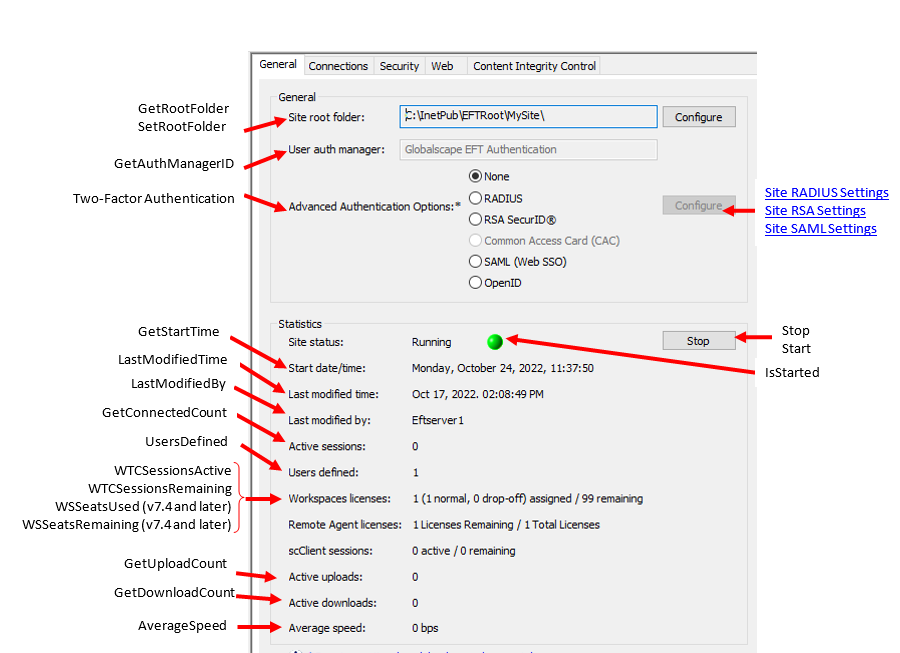
The ICISite RADIUS authentication properties correlate to the following fields and controls in the EFT administration interface:

Site RSA Configuration Setting

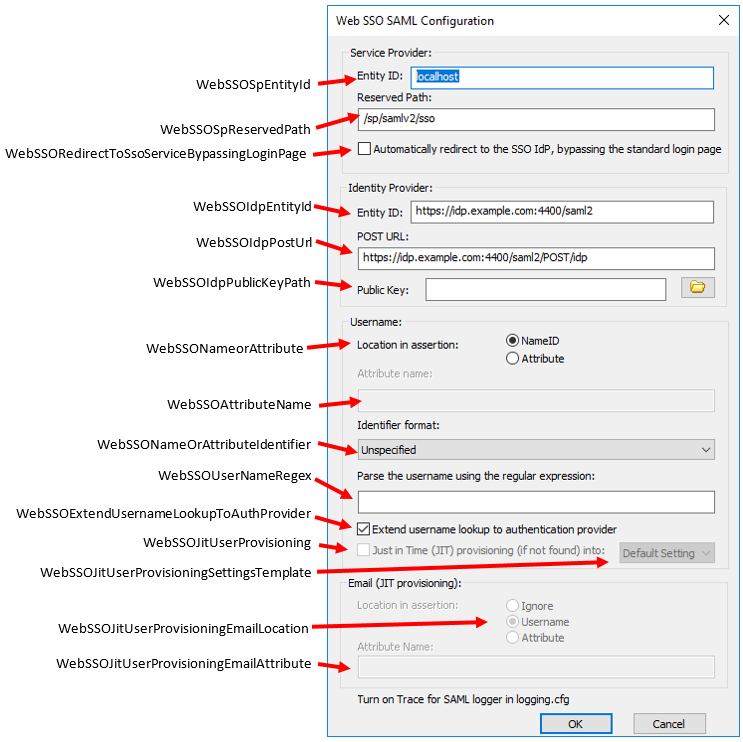
The ODBCSettings property correlates to the Use this user attribute as logon name setting in the Windows Authentication Options dialog box. Other substrings appearing in the string depend on settings in the Windows Authentication Options dialog box. For example, if Create a virtual folder pointing to the user's home folder as defined in his/her AD profile is selected, the "CreateVirtualHF=1" substring is present in the ODBCSettings string; if Create a physical folder under the site root folder using the user's login name is selected, the "CreateVirtualHF=1" substring is not present in the ODBCSettings string.
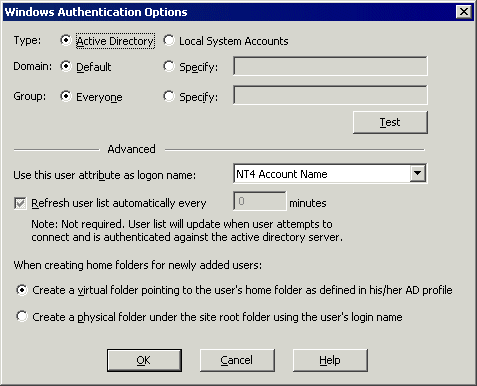
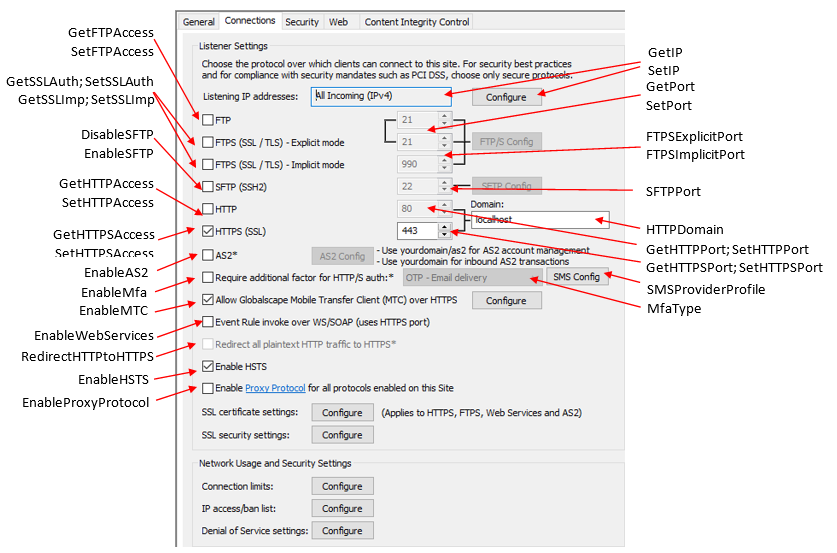

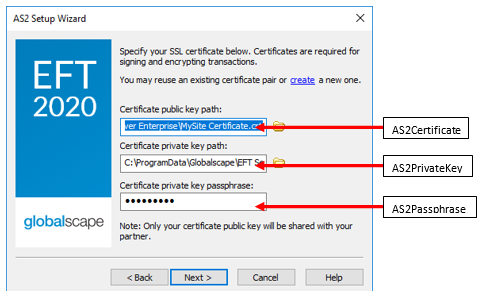
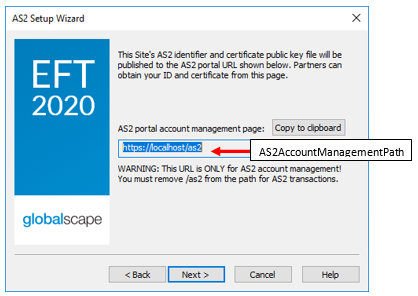
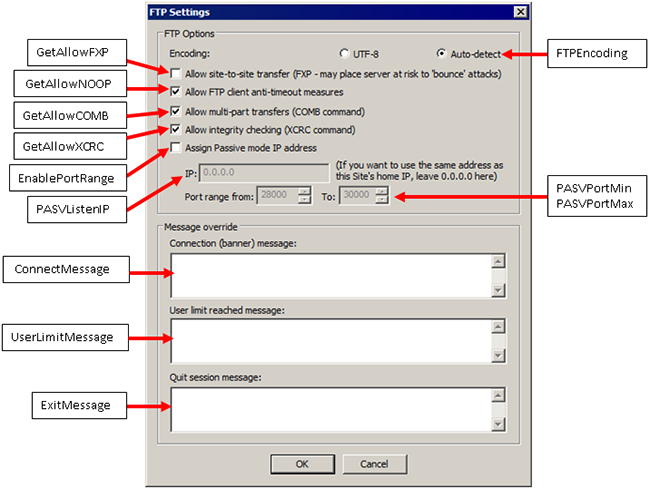
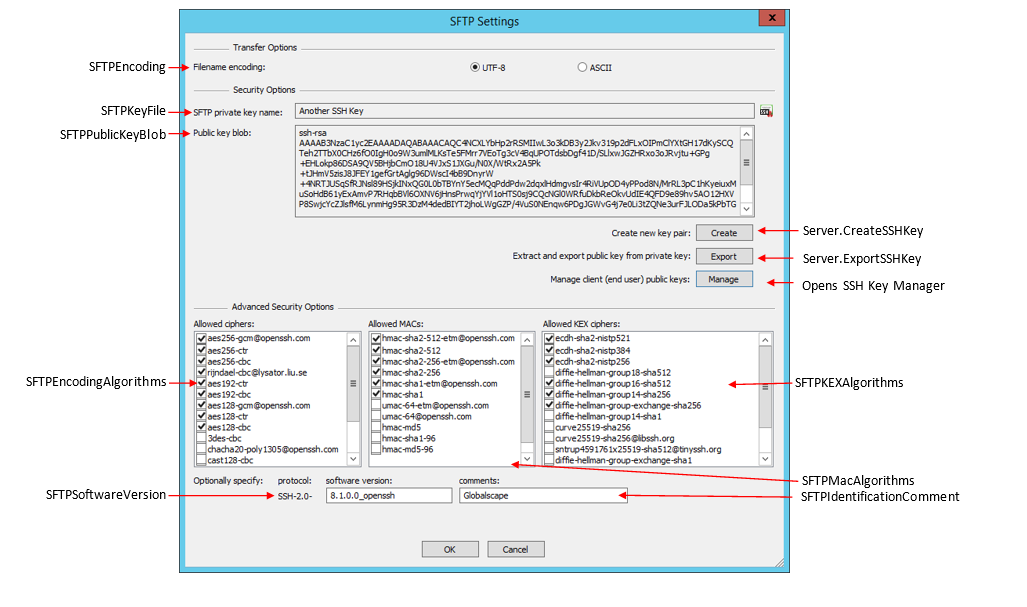
Mobile Transfer Client Security
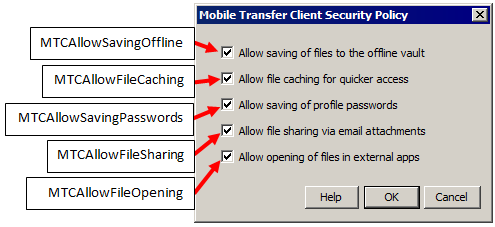
These parameters also can be viewed/set in the Administrator interface on the Connections tab of the Site.
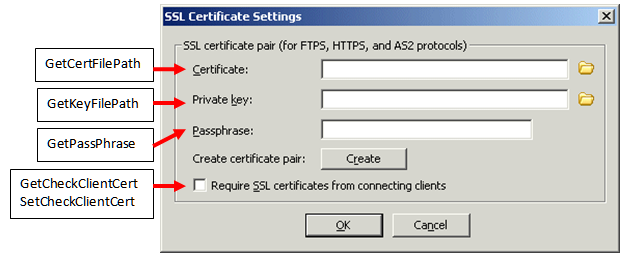

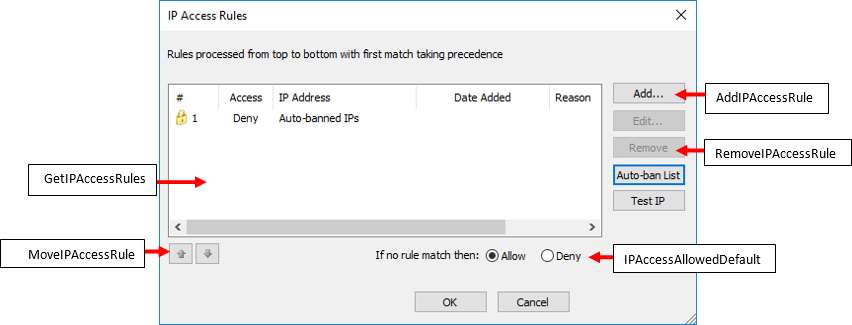

Site Anti-flood/Hammer Settings

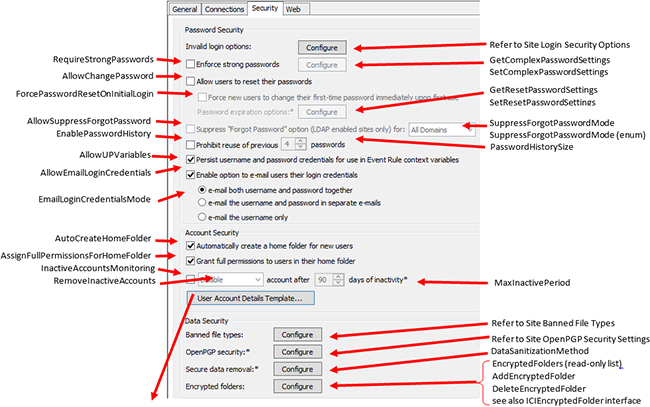

Site Invalid login (Login Security) options

The Site data security settings can be viewed or set in the administration interface on the Site's Security tab.

Site OpenPGP Security Settings
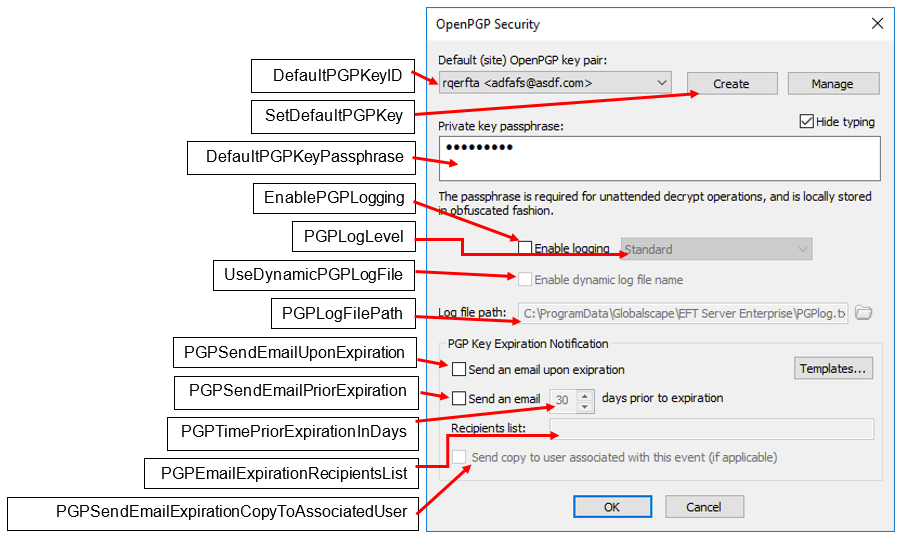
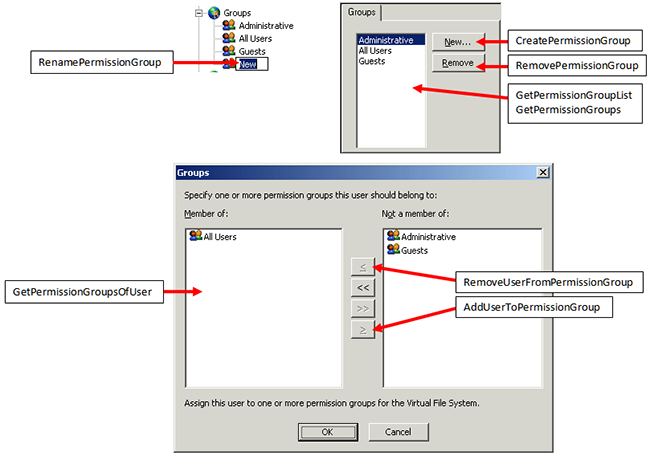
Site > Web tab (EFT v8 and later)
Folder sharing:

Send portal:
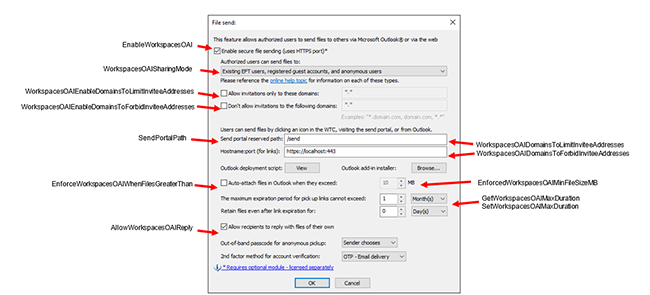
Drop-off portal:
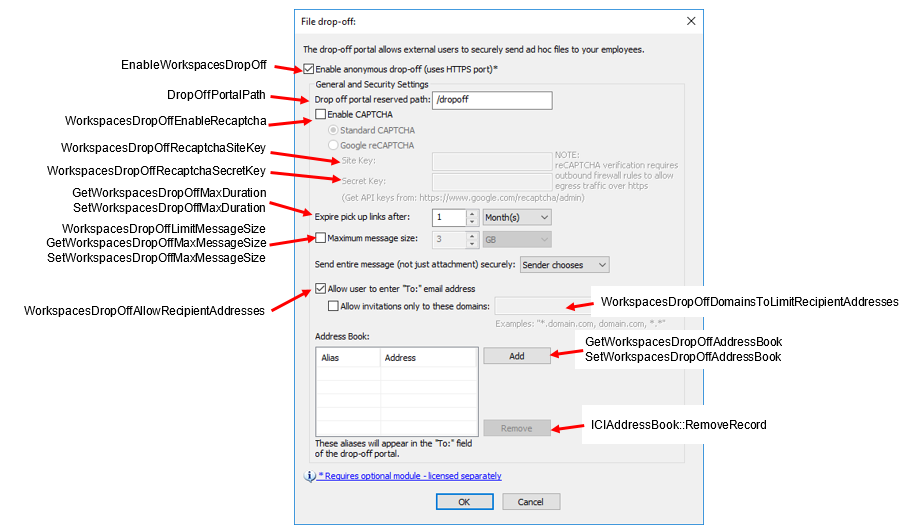
Account Management:

For Privacy Policy, Terms of Service, and GDPR, refer to GDPR and Privacy Settings.